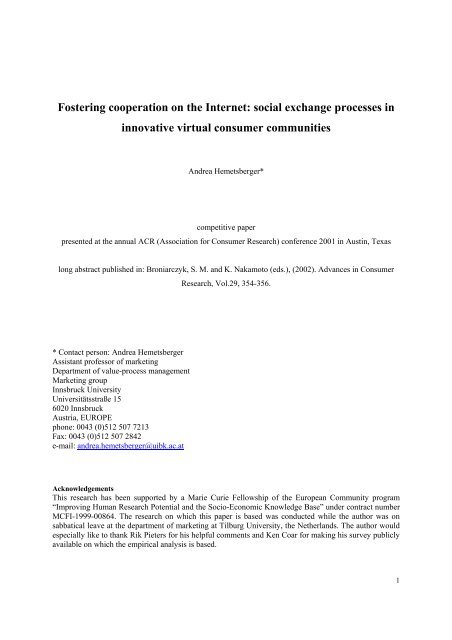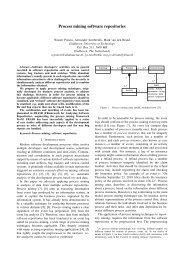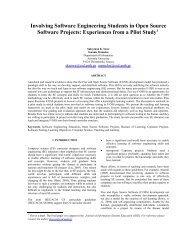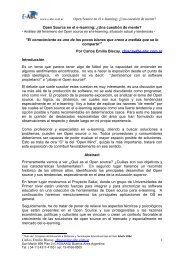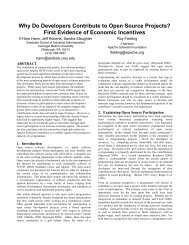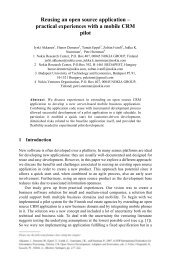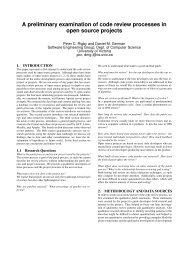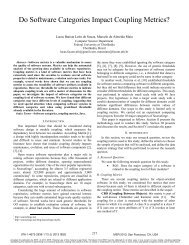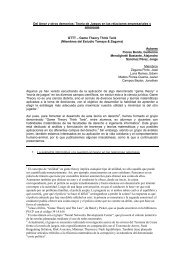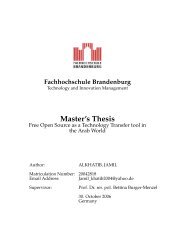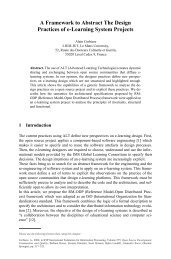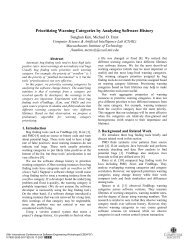Fostering cooperation on the Internet: social exchange processes in ...
Fostering cooperation on the Internet: social exchange processes in ...
Fostering cooperation on the Internet: social exchange processes in ...
You also want an ePaper? Increase the reach of your titles
YUMPU automatically turns print PDFs into web optimized ePapers that Google loves.
<str<strong>on</strong>g>Foster<strong>in</strong>g</str<strong>on</strong>g> <str<strong>on</strong>g>cooperati<strong>on</strong></str<strong>on</strong>g> <strong>on</strong> <strong>the</strong> <strong>Internet</strong>: <strong>social</strong> <strong>exchange</strong> <strong>processes</strong> <strong>in</strong><strong>in</strong>novative virtual c<strong>on</strong>sumer communitiesAndrea Hemetsberger*competitive paperpresented at <strong>the</strong> annual ACR (Associati<strong>on</strong> for C<strong>on</strong>sumer Research) c<strong>on</strong>ference 2001 <strong>in</strong> Aust<strong>in</strong>, Texasl<strong>on</strong>g abstract published <strong>in</strong>: Br<strong>on</strong>iarczyk, S. M. and K. Nakamoto (eds.), (2002). Advances <strong>in</strong> C<strong>on</strong>sumerResearch, Vol.29, 354-356.* C<strong>on</strong>tact pers<strong>on</strong>: Andrea HemetsbergerAssistant professor of market<strong>in</strong>gDepartment of value-process managementMarket<strong>in</strong>g groupInnsbruck UniversityUniversitätsstraße 156020 InnsbruckAustria, EUROPEph<strong>on</strong>e: 0043 (0)512 507 7213Fax: 0043 (0)512 507 2842e-mail: andrea.hemetsberger@uibk.ac.atAcknowledgementsThis research has been supported by a Marie Curie Fellowship of <strong>the</strong> European Community program“Improv<strong>in</strong>g Human Research Potential and <strong>the</strong> Socio-Ec<strong>on</strong>omic Knowledge Base” under c<strong>on</strong>tract numberMCFI-1999-00864. The research <strong>on</strong> which this paper is based was c<strong>on</strong>ducted while <strong>the</strong> author was <strong>on</strong>sabbatical leave at <strong>the</strong> department of market<strong>in</strong>g at Tilburg University, <strong>the</strong> Ne<strong>the</strong>rlands. The author wouldespecially like to thank Rik Pieters for his helpful comments and Ken Coar for mak<strong>in</strong>g his survey publiclyavailable <strong>on</strong> which <strong>the</strong> empirical analysis is based.1
<str<strong>on</strong>g>Foster<strong>in</strong>g</str<strong>on</strong>g> <str<strong>on</strong>g>cooperati<strong>on</strong></str<strong>on</strong>g> <strong>on</strong> <strong>the</strong> <strong>Internet</strong>: <strong>social</strong> <strong>exchange</strong> <strong>processes</strong> <strong>in</strong><strong>in</strong>novative virtual c<strong>on</strong>sumer communitiesAbstractVirtual communities of c<strong>on</strong>sumers <strong>in</strong>creas<strong>in</strong>gly engage <strong>in</strong> voluntary collaborative producti<strong>on</strong> ofdigital goods and services which became highly successful <strong>in</strong> recent years. This paper offers a<strong>the</strong>oretical c<strong>on</strong>ceptualizati<strong>on</strong> and empirical evidence of <strong>the</strong> key elements and <strong>processes</strong> of<strong>exchange</strong> <strong>in</strong> those communities. With<strong>in</strong> a culture of gift-giv<strong>in</strong>g and generalized <strong>social</strong> <strong>exchange</strong>,knowledge as <strong>the</strong> ma<strong>in</strong> resource of <strong>the</strong> community is multiplied by giv<strong>in</strong>g it away freely to o<strong>the</strong>rsand thus, fosters c<strong>on</strong>tributi<strong>on</strong> behavior. Friendship, peer reputati<strong>on</strong> and external feed-backprovided by a global user community represent highly motivat<strong>in</strong>g <strong>social</strong> rewards which,comb<strong>in</strong>ed with <strong>in</strong>dividual ga<strong>in</strong> of knowledge, c<strong>on</strong>stitute a self-susta<strong>in</strong><strong>in</strong>g system of <strong>exchange</strong>.2
<str<strong>on</strong>g>Foster<strong>in</strong>g</str<strong>on</strong>g> <str<strong>on</strong>g>cooperati<strong>on</strong></str<strong>on</strong>g> <strong>on</strong> <strong>the</strong> <strong>Internet</strong>: <strong>social</strong> <strong>exchange</strong> <strong>processes</strong> <strong>in</strong> <strong>in</strong>novativevirtual c<strong>on</strong>sumer communitiesINTRODUCTIONThere is wide agreement <strong>in</strong> market<strong>in</strong>g literature that creat<strong>in</strong>g value for customers is at <strong>the</strong> core of<strong>the</strong> market<strong>in</strong>g effort (Kotler, 1997). Whereas – until recently - most market<strong>in</strong>g research explicitlyor implicitly has restricted value-creati<strong>on</strong> to <strong>in</strong>novati<strong>on</strong>, producti<strong>on</strong> and delivery <strong>processes</strong> ofproducts and services by organizati<strong>on</strong>s, <strong>the</strong>re is <strong>in</strong>creas<strong>in</strong>g academic discourse aboutc<strong>on</strong>sumpti<strong>on</strong> as a value-creat<strong>in</strong>g activity (Tzokas and Saren, 1997; Holbrook, 1994; Holt, 1995;Firat and Venkatesh, 1995; Gummess<strong>on</strong>, 1998). It has been argued that c<strong>on</strong>sumers’ <strong>in</strong>volvement<strong>in</strong> value creat<strong>in</strong>g activities is still underestimated and c<strong>on</strong>stitutes a gap <strong>in</strong> market<strong>in</strong>g <strong>the</strong>ory(Tzokas and Saren, 1997). Remarkable excepti<strong>on</strong>s can be found especially <strong>in</strong> <strong>the</strong> relati<strong>on</strong>ship andservices market<strong>in</strong>g literature (Kelley et al., 1990; 1992; Schneider and Bowen, 1995; Wikström,1996; Bettencourt, 1997) as well as <strong>in</strong> lead-user research (v<strong>on</strong> Hippel, 1988; 1998; Lakhani andv<strong>on</strong> Hippel, 2000). However, <strong>the</strong> possibilities of customers for jo<strong>in</strong>t value creati<strong>on</strong> as a coproduceris limited to <strong>the</strong> characteristics of <strong>the</strong> product or service and to <strong>the</strong>ir own unique meansof value creati<strong>on</strong> <strong>in</strong> <strong>the</strong>ir own doma<strong>in</strong>. The rapid growth of new communicati<strong>on</strong> technologies haschanged <strong>the</strong>se limitati<strong>on</strong>s dramatically and “new possibilities are emerg<strong>in</strong>g that did not existbefore.” (Firat and Venkatesh 1995, p.239). On <strong>the</strong> <strong>Internet</strong> <strong>in</strong>formati<strong>on</strong> and digital goods, suchas music or software are easily and <strong>in</strong>expensively accessible for c<strong>on</strong>sumers. Moreover, it allowsc<strong>on</strong>sumers to engage <strong>in</strong> <strong>social</strong> <strong>in</strong>teracti<strong>on</strong> with o<strong>the</strong>r c<strong>on</strong>sumers, exchang<strong>in</strong>g <strong>in</strong>formati<strong>on</strong> andcollectively creat<strong>in</strong>g knowledge. C<strong>on</strong>sumers <strong>in</strong>creas<strong>in</strong>gly engage <strong>in</strong> collaborative producti<strong>on</strong> of3
goods and services <strong>on</strong> <strong>the</strong> <strong>Internet</strong> rang<strong>in</strong>g from music compilati<strong>on</strong>s, computer games, andsearchable <strong>on</strong>-l<strong>in</strong>e databases to <strong>the</strong> collective development of software.As produc<strong>in</strong>g c<strong>on</strong>sumer groups do not need to make major <strong>in</strong>vestments, besides acomputer <strong>in</strong> a network and <strong>the</strong>ir bra<strong>in</strong>s, <strong>the</strong>y are no l<strong>on</strong>ger dependent <strong>on</strong> firms produc<strong>in</strong>g digitalgoods, but <strong>in</strong>stead jo<strong>in</strong>tly create and <strong>exchange</strong> digital products <strong>the</strong>mselves. Fur<strong>the</strong>rmore, andeven more important, <strong>the</strong>y produce digital goods and provide <strong>on</strong>-l<strong>in</strong>e services that better fulfill<strong>the</strong>ir own needs. Virtual communities of creative c<strong>on</strong>sumers, <strong>the</strong>refore, dramatically challenge<strong>the</strong> hi<strong>the</strong>rto prevail<strong>in</strong>g view that <strong>the</strong> sphere of producti<strong>on</strong> is separated from <strong>the</strong> sphere ofc<strong>on</strong>sumpti<strong>on</strong> (Firat and Venkatesh, 1995). In view of <strong>the</strong>se developments customer-orientati<strong>on</strong> isgiven new mean<strong>in</strong>g and <strong>the</strong> c<strong>on</strong>tents and <strong>processes</strong> of <strong>exchange</strong> between companies andcustomers will have to be rec<strong>on</strong>sidered if firms want to keep <strong>the</strong>ir customers and cooperate with<strong>the</strong>m.Establish<strong>in</strong>g and ma<strong>in</strong>ta<strong>in</strong><strong>in</strong>g mutually reward<strong>in</strong>g <strong>exchange</strong> relati<strong>on</strong>ships is c<strong>on</strong>sidered animportant prerequisite for successful <str<strong>on</strong>g>cooperati<strong>on</strong></str<strong>on</strong>g> (Morgan and Hunt, 1994). Establish<strong>in</strong>g andma<strong>in</strong>ta<strong>in</strong><strong>in</strong>g a cooperative relati<strong>on</strong>ship with produc<strong>in</strong>g c<strong>on</strong>sumers, <strong>the</strong>refore, requires a holisticunderstand<strong>in</strong>g of (1) what c<strong>on</strong>sumers c<strong>on</strong>sider as reward<strong>in</strong>g and (2) how to ma<strong>in</strong>ta<strong>in</strong> a mutuallybeneficial system of <strong>exchange</strong> <strong>on</strong> <strong>the</strong> <strong>Internet</strong> over time.The purpose of this paper is to c<strong>on</strong>ceptualize and explore <strong>the</strong> specific c<strong>on</strong>tents and<strong>processes</strong> of cooperative <strong>exchange</strong> relati<strong>on</strong>ships <strong>on</strong> <strong>the</strong> <strong>Internet</strong>. First, a brief descripti<strong>on</strong> of <strong>the</strong>background and <strong>social</strong> structure of a successful creative community – <strong>the</strong> open-sourcecommunity - is offered. Sec<strong>on</strong>d, <strong>exchange</strong> c<strong>on</strong>tents and <strong>processes</strong> <strong>in</strong> produc<strong>in</strong>g virtualcommunities are c<strong>on</strong>ceptualized. Exploratory evidence is based <strong>on</strong> more than 1400 resp<strong>on</strong>ses toan <strong>Internet</strong> survey with open-ended questi<strong>on</strong>s am<strong>on</strong>g members of <strong>the</strong> open-source community.4
F<strong>in</strong>ally, <strong>the</strong> typical <strong>exchange</strong> <strong>processes</strong> <strong>in</strong> <strong>in</strong>novative virtual communities are traced, and itsimplicati<strong>on</strong>s discussed.THE OPEN-SOURCE COMMUNITYOne of <strong>the</strong> most <strong>in</strong>trigu<strong>in</strong>g and <strong>in</strong>sightful examples of <strong>on</strong>-l<strong>in</strong>e jo<strong>in</strong>t-producti<strong>on</strong> is <strong>the</strong> immenseproductivity of <strong>the</strong> open-source community and <strong>the</strong> global success of open-source software.Thousands of expert programmers and milli<strong>on</strong>s of users worldwide voluntarily work <strong>on</strong> new and<strong>on</strong> <strong>the</strong> improvement of exist<strong>in</strong>g open-source software. The dist<strong>in</strong>ctive element of this effortcompared to o<strong>the</strong>r free provisi<strong>on</strong>s of digital goods is that <strong>the</strong> core of software <strong>in</strong>novati<strong>on</strong>, <strong>the</strong>source code, is <strong>in</strong>cluded. Historically, <strong>the</strong> free software culture around its prom<strong>in</strong>ent protag<strong>on</strong>istRichard M. Stallman who was work<strong>in</strong>g at MIT Artificial Intelligence Laboratories started as ananti-commercial and ‘software wants to be free’ movement. However, <strong>the</strong>re was always also amore pragmatic stra<strong>in</strong>, loyal to open-source but not because of its ideology but founded <strong>on</strong> <strong>the</strong>striv<strong>in</strong>g for technological superiority and <strong>the</strong> belief that open-source is <strong>the</strong> better way to achievethis goal. However, <strong>in</strong> ei<strong>the</strong>r group <strong>the</strong> genu<strong>in</strong>e culture of shar<strong>in</strong>g of ideas, free <strong>exchange</strong> of<strong>in</strong>formati<strong>on</strong> and free speech (Berners-Lee, 2000) of <strong>the</strong> early ‘hackers’ who <strong>in</strong>vented <strong>the</strong> WorldWide Web is still prevalent.One of <strong>the</strong> most prom<strong>in</strong>ent examples of open-source development is <strong>the</strong> operat<strong>in</strong>g systemL<strong>in</strong>ux which by now is said to be <strong>on</strong>e of <strong>the</strong> ma<strong>in</strong> Web server platforms worldwide. The L<strong>in</strong>uxkernel has been programmed from scratch by a former F<strong>in</strong>nish student who published <strong>the</strong> sourcecode <strong>on</strong> <strong>the</strong> <strong>Internet</strong> and attracted hundreds and thousands of professi<strong>on</strong>al and hobbyistprogrammers to c<strong>on</strong>tribute code and improve <strong>on</strong> <strong>the</strong> new kernel of <strong>the</strong> Unix-like operat<strong>in</strong>g systemfor PC's. Like every o<strong>the</strong>r open-source software, L<strong>in</strong>ux is free for everybody to download and – if5
experienced enough – to c<strong>on</strong>tribute to <strong>the</strong> source code. In <strong>exchange</strong> for be<strong>in</strong>g able to use andmodify <strong>the</strong> software, <strong>the</strong> users of software have to make <strong>the</strong>ir c<strong>on</strong>tributi<strong>on</strong> also freely available aswell as not to impose any licens<strong>in</strong>g restricti<strong>on</strong>s to o<strong>the</strong>rs.Although <strong>the</strong> first L<strong>in</strong>ux distributi<strong>on</strong>s already started <strong>in</strong> 1994, it took some time for <strong>the</strong>wider public, <strong>in</strong>clud<strong>in</strong>g <strong>the</strong> press, governments and <strong>the</strong> computer <strong>in</strong>dustry, to react. At this time,<strong>the</strong> open-source <strong>in</strong>itiative was brought <strong>in</strong>to existence <strong>in</strong> order to provide an organizati<strong>on</strong>alplatform for <str<strong>on</strong>g>cooperati<strong>on</strong></str<strong>on</strong>g> between <strong>the</strong> developer community and companies. By now, Netscape,Sun Microsystems, to name some of <strong>the</strong> most prom<strong>in</strong>ent corporati<strong>on</strong>s, have released <strong>the</strong> Mozillaand StarOffice source code, several o<strong>the</strong>r hard- and software providers have ported <strong>the</strong>ir productsto L<strong>in</strong>ux, some of <strong>the</strong> most powerful companies <strong>in</strong> <strong>the</strong> computer <strong>in</strong>dustry actively work toge<strong>the</strong>rwith open-source developers, and L<strong>in</strong>ux distributi<strong>on</strong>s, like Red Hat, Caldera, Debian, Mandrake,or SuSE are grow<strong>in</strong>g rapidly. L<strong>in</strong>ux was by far not <strong>the</strong> first open-source project and, <strong>in</strong> <strong>the</strong>meantime, thousands of o<strong>the</strong>r open-source projects are coord<strong>in</strong>ated <strong>on</strong>-l<strong>in</strong>e.Developers and users of open-source software are often referred to as ‘<strong>the</strong> open-sourcecommunity’ (OS-community). As Rhe<strong>in</strong>gold def<strong>in</strong>ed it, virtual communities are "<strong>social</strong>aggregati<strong>on</strong>s that emerge when enough people carry <strong>on</strong>…public discussi<strong>on</strong>s l<strong>on</strong>g enough, withsufficient human feel<strong>in</strong>g, to form webs of pers<strong>on</strong>al relati<strong>on</strong>ships <strong>in</strong> cyberspace." (Rhe<strong>in</strong>gold,1993, p.5). Members communicate <strong>on</strong> specific virtual and ‘real’ platforms where <strong>in</strong>tenseeveryday <strong>in</strong>teracti<strong>on</strong> and discourse takes place. Thus, <strong>the</strong>y build a group of people who share<strong>social</strong> <strong>in</strong>teracti<strong>on</strong>, and a comm<strong>on</strong> ‘space’ (Koz<strong>in</strong>ets, 1999). Fur<strong>the</strong>rmore, members of <strong>the</strong> opensourcecommunity share a comm<strong>on</strong> <strong>in</strong>terest which fits Armstr<strong>on</strong>g and Hagel’s (1996) def<strong>in</strong>iti<strong>on</strong>of virtual ‘communities of <strong>in</strong>terest’. However, <strong>the</strong> open-source community c<strong>on</strong>stitutes not <strong>on</strong>es<strong>in</strong>gle huge community, but is better thought of as a virtual c<strong>on</strong>glomerate of ‘project6
communities’ (e.g.: <strong>the</strong> L<strong>in</strong>ux-community, <strong>the</strong> Apache-community) which are bound toge<strong>the</strong>r bysimilar <strong>in</strong>terests and striv<strong>in</strong>gs but committed to specific projects (van Rossum, 1999; Raym<strong>on</strong>d,1999). Depend<strong>in</strong>g <strong>on</strong> <strong>the</strong> size of <strong>the</strong> project <strong>the</strong>re is ei<strong>the</strong>r <strong>on</strong>e developer team or a biggercommunity c<strong>on</strong>sist<strong>in</strong>g of a number of c<strong>on</strong>tributors ga<strong>the</strong>r<strong>in</strong>g around a core development team.Apart from <strong>the</strong>se core teams and developers that build <strong>the</strong> center of <strong>the</strong> <strong>in</strong>novative effort a hugenumber of affiliates ga<strong>the</strong>r around those groups, <strong>the</strong>ir products and ideas. Their degree of <strong>social</strong><strong>in</strong>teracti<strong>on</strong> and c<strong>on</strong>tributi<strong>on</strong> varies c<strong>on</strong>siderably, thus <strong>the</strong> term community seems to exaggerate<strong>the</strong> <strong>social</strong> b<strong>on</strong>ds that exist <strong>in</strong> reality. What is called <strong>the</strong> open-source community may be betterthought of as an <strong>on</strong>l<strong>in</strong>e <strong>social</strong> network of people <strong>in</strong>teract<strong>in</strong>g with each o<strong>the</strong>r c<strong>on</strong>t<strong>in</strong>ually(Rhe<strong>in</strong>gold, 2000) with vary<strong>in</strong>g degree of <strong>social</strong> <strong>in</strong>teracti<strong>on</strong> and feel<strong>in</strong>gs of bel<strong>on</strong>g<strong>in</strong>gness.THEORETICAL BACKGROUNDModels and rules of <strong>exchange</strong>For decades, market<strong>in</strong>g has been described as <strong>the</strong> process of creat<strong>in</strong>g, resolv<strong>in</strong>g andma<strong>in</strong>ta<strong>in</strong><strong>in</strong>g <strong>exchange</strong> relati<strong>on</strong>ships (Bagozzi, 1974). This <strong>in</strong>volves a “set of <strong>social</strong> actors, <strong>the</strong>irrelati<strong>on</strong>ships to each o<strong>the</strong>r, and endogeneous and exogeneous variables affect<strong>in</strong>g <strong>the</strong> behavior of<strong>the</strong> <strong>social</strong> actors <strong>in</strong> those relati<strong>on</strong>ships.” (Bagozzi, 1974, p.78). The basic assumpti<strong>on</strong> is that<strong>in</strong>dividuals are compelled to participate <strong>in</strong> an <strong>exchange</strong> relati<strong>on</strong>ship <strong>in</strong> order to satisfy <strong>the</strong>ir needs(March and Sim<strong>on</strong>, 1958; Bagozzi, 1975). Apart from o<strong>the</strong>r important stakeholders, meet<strong>in</strong>g <strong>the</strong>needs of customers has always been at <strong>the</strong> core of <strong>the</strong> market<strong>in</strong>g effort. Fulfill<strong>in</strong>g customers’needs requires knowledge about what, when and how to provide appropriate benefits <strong>in</strong> order toestablish and ma<strong>in</strong>ta<strong>in</strong> l<strong>on</strong>g-term customer <strong>exchange</strong> relati<strong>on</strong>ships.Market<strong>in</strong>g literature offers various c<strong>on</strong>ceptualizati<strong>on</strong>s about how to design <strong>exchange</strong>relati<strong>on</strong>ships (Bagozzi, 1975; Hirschman, 1987; Morgan and Hunt, 1994; Grönroos, 1999).7
However, models of <strong>exchange</strong> differ c<strong>on</strong>siderably <strong>in</strong> <strong>the</strong>ir view about what is <strong>exchange</strong>d betweentwo parties and how <strong>exchange</strong> is <strong>in</strong>fluence by various endogenous and exogenous factors. The‘ec<strong>on</strong>omic model’ assumes that th<strong>in</strong>gs are <strong>exchange</strong>d for <strong>the</strong>ir ec<strong>on</strong>omic or utilitarian value,whereas accord<strong>in</strong>g to <strong>the</strong> ‘<strong>social</strong> model’ <strong>exchange</strong> takes place <strong>on</strong> <strong>the</strong> basis of <strong>the</strong> symbolic valueattached to th<strong>in</strong>gs (Ekeh, 1974).Both views assume that <strong>in</strong>dividuals engage <strong>in</strong> <strong>exchange</strong> to achieve certa<strong>in</strong> important goalsthat are extr<strong>in</strong>sic to <strong>the</strong> behavior <strong>the</strong>y engage <strong>in</strong>. Extr<strong>in</strong>sic or <strong>in</strong>strumental rewards are amotivati<strong>on</strong> source when <strong>in</strong>dividuals believe that behavior will lead to certa<strong>in</strong> valued outcomes,utilitarian and/or symbolic. Social <strong>in</strong>teracti<strong>on</strong> is viewed as an <strong>exchange</strong> of mutually reward<strong>in</strong>gactivities <strong>in</strong> which <strong>the</strong> receipt of a needed valuable is c<strong>on</strong>t<strong>in</strong>gent <strong>on</strong> <strong>the</strong> supply of a favor <strong>in</strong>return. Expectati<strong>on</strong>s of reciprocity are based <strong>on</strong> <strong>the</strong> rati<strong>on</strong>al grounds that <strong>in</strong>dividuals evaluate <strong>the</strong><strong>in</strong>put/output ratio of a certa<strong>in</strong> behavior <strong>in</strong> relati<strong>on</strong> to a referent o<strong>the</strong>r. Equity <strong>the</strong>ory (Walster etal., 1978) assumes that people tend to balance this ratio simply by return<strong>in</strong>g appropriateutilitarian and <strong>social</strong> rewards for <strong>the</strong> benefits ga<strong>in</strong>ed. Whereas most ec<strong>on</strong>omic transacti<strong>on</strong>s aresimultaneous <strong>exchange</strong>s <strong>in</strong>dividuals, with<strong>in</strong> <strong>the</strong> <strong>social</strong> model, rely <strong>on</strong> and trust each o<strong>the</strong>r forfuture favors. This creates a ‘general <strong>social</strong> <strong>in</strong>debtedness’ that forms <strong>the</strong> basis of a community(Haas and Deseran, 1981). Accord<strong>in</strong>g to this view susta<strong>in</strong>able <strong>social</strong> <strong>exchange</strong> depends <strong>on</strong>whe<strong>the</strong>r this system of <strong>exchange</strong> can be kept <strong>in</strong> balance <strong>in</strong> general, over time, and across peoplera<strong>the</strong>r than <strong>on</strong> an immediate, <strong>on</strong>e-to-<strong>on</strong>e basis.Organizati<strong>on</strong>al <strong>the</strong>orists agree that people not <strong>on</strong>ly apply equity rules but use a variety ofpr<strong>in</strong>ciples and values as <strong>the</strong> basis for <strong>exchange</strong> (Kabanoff, 1991). Equity, equality or o<strong>the</strong>r rules,such as <strong>the</strong> need pr<strong>in</strong>ciple are called <strong>on</strong>, depend<strong>in</strong>g <strong>on</strong> <strong>the</strong> nature of <strong>the</strong> <strong>social</strong> c<strong>on</strong>text or <strong>the</strong><strong>social</strong> <strong>in</strong>terdependence that is <strong>in</strong>volved. Deutsch (1985) found that <strong>in</strong> task-directed relati<strong>on</strong>shipspeople tend to adopt distributive pr<strong>in</strong>ciples of equity accord<strong>in</strong>g to <strong>the</strong> potential to c<strong>on</strong>tribute and8
<strong>the</strong> actual c<strong>on</strong>tributi<strong>on</strong> of <strong>in</strong>dividuals. In relati<strong>on</strong>s <strong>in</strong> which <strong>the</strong> foster<strong>in</strong>g of enjoyable <strong>social</strong>relati<strong>on</strong>s is <strong>the</strong> comm<strong>on</strong> goal, equality tends to be <strong>the</strong> dom<strong>in</strong>at<strong>in</strong>g pr<strong>in</strong>ciple. Equality signifiesthat <strong>the</strong> different members of a relati<strong>on</strong>ship have equal value as <strong>in</strong>dividuals, <strong>in</strong>dependent of <strong>the</strong>irpotential or actual <strong>in</strong>put. The orientati<strong>on</strong> of relati<strong>on</strong>ship as its own goal is n<strong>on</strong>-<strong>in</strong>strumentalbecause <strong>the</strong> source of acti<strong>on</strong>s is based <strong>on</strong> a pers<strong>on</strong>'s sense of his or her relati<strong>on</strong>ship with <strong>the</strong> o<strong>the</strong>rpers<strong>on</strong>, ra<strong>the</strong>r than <strong>on</strong> a judgment of that pers<strong>on</strong>'s c<strong>on</strong>tributi<strong>on</strong>. It has been argued that equityemphasizes productivity, whereas equality emphasizes solidarity and l<strong>on</strong>g-term relati<strong>on</strong>ships(Kabanoff, 1991).Relati<strong>on</strong>ship market<strong>in</strong>g radically departed from <strong>the</strong> ec<strong>on</strong>omic transacti<strong>on</strong> view to <strong>the</strong>c<strong>on</strong>cept of relati<strong>on</strong>al <strong>exchange</strong>, which reflects an <strong>on</strong>go<strong>in</strong>g process (Morgan and Hunt, 1994).Emphasis is put <strong>on</strong> l<strong>on</strong>g-term relati<strong>on</strong>ships between partners and <strong>the</strong>refore, especially <strong>on</strong> <strong>the</strong>c<strong>on</strong>tents and <strong>processes</strong> of <strong>exchange</strong> that ma<strong>in</strong>ta<strong>in</strong> mutually beneficial relati<strong>on</strong>ships.Corresp<strong>on</strong>d<strong>in</strong>g values are important moderators for solidarity and loyalty <strong>in</strong> relati<strong>on</strong>ships(Anders<strong>on</strong> et al, 1999). Social <strong>exchange</strong> is not primarily based <strong>on</strong> expectati<strong>on</strong>s of immediate andclearly specified rewards but ra<strong>the</strong>r <strong>on</strong> unspecific and general hope for <strong>social</strong> approval. “Mostpeople like help<strong>in</strong>g o<strong>the</strong>rs and do<strong>in</strong>g a favor. Favors make us grateful and our expressi<strong>on</strong>s ofgratitude are <strong>social</strong> rewards that tend to make do<strong>in</strong>g favors enjoyable. We tend to reciprocate aswe are grateful and feel obligated.” (Blau 1964, p.16). One way that groups and society regulatereciprocati<strong>on</strong> is through <strong>the</strong> establishment of <strong>social</strong> norms. Descriptive norms specify what mostpeople do <strong>in</strong> a particular situati<strong>on</strong> whereas <strong>in</strong>junctive norms <strong>in</strong>dicate what ought to or should bed<strong>on</strong>e (Ciald<strong>in</strong>i et al., 1990; 1991). Violat<strong>in</strong>g <strong>in</strong>junctive norms makes us feel guilty or creates afeel<strong>in</strong>g of <strong>in</strong>debtedness, thus we feel obliged to behave accord<strong>in</strong>g to <strong>the</strong> group’s rules of<strong>exchange</strong> (Olsen, 1978). This is what Etzi<strong>on</strong>i (1975) refers to as moral <strong>in</strong>volvement which is <strong>the</strong>result of <strong>in</strong>ternalizati<strong>on</strong> of <strong>social</strong> norms or culturally-based c<strong>on</strong>victi<strong>on</strong>s (Durkheim, 1973). In9
c<strong>on</strong>trast, <strong>in</strong>dividuals act accord<strong>in</strong>g to descriptive norms when <strong>the</strong>y do what is d<strong>on</strong>e <strong>in</strong> a particularsituati<strong>on</strong> with<strong>in</strong> a specific culture.Belk and Co<strong>on</strong> challenged <strong>the</strong> paradigmatic assumpti<strong>on</strong> of reciprocity <strong>in</strong> <strong>exchange</strong> modelsby ask<strong>in</strong>g: "Do we give <strong>on</strong>ly to get someth<strong>in</strong>g <strong>in</strong> return?" (Belk and Co<strong>on</strong> 1993, p.393) and<strong>in</strong>troduced <strong>the</strong> agapic love metaphor as an alternative explanati<strong>on</strong> for gift-giv<strong>in</strong>g behavior.Theories of gift-giv<strong>in</strong>g, <strong>in</strong> general posit that <strong>the</strong> <strong>social</strong> significance of products arises not solelyby be<strong>in</strong>g displayed by <strong>the</strong>ir owner but ra<strong>the</strong>r by be<strong>in</strong>g given away as gifts to o<strong>the</strong>rs (Mauss et al.,1970). “In gift-cultures, <strong>social</strong> status is determ<strong>in</strong>ed not by what you c<strong>on</strong>trol, but what you giveaway.” (Raym<strong>on</strong>d, 1999, p.99). Although gift-giv<strong>in</strong>g with<strong>in</strong> communities also implies that peoplereciprocate and give back what <strong>the</strong>y are able to give, gifts may also be given without expectati<strong>on</strong>sof anyth<strong>in</strong>g <strong>in</strong> return. Murn<strong>in</strong>ghan et al., for <strong>in</strong>stance, argued that <strong>the</strong> key difference betweensystems of reciprocal altruism and volunteer<strong>in</strong>g is that a voluntary act rarely <strong>in</strong>cludes str<strong>on</strong>greciprocal expectati<strong>on</strong>s. Ra<strong>the</strong>r, volunteer<strong>in</strong>g may depend <strong>on</strong> emoti<strong>on</strong>al, moral, or empathicfeel<strong>in</strong>gs that are typically associated with altruism (Murn<strong>in</strong>ghan et al., 1993, p.516). Similararguments can be found <strong>in</strong> various c<strong>on</strong>tributi<strong>on</strong>s <strong>on</strong> pro<strong>social</strong> behavior (Thomps<strong>on</strong> and B<strong>on</strong>o,1993; J<strong>in</strong>, 1993; Fernando and Hest<strong>on</strong>, 1997; van Oorschot, 1999). Individuals learn ‘altruistic’behavior <strong>in</strong> <strong>the</strong> sense of ‘do<strong>in</strong>g someth<strong>in</strong>g good’ for o<strong>the</strong>rs. It is not based <strong>on</strong> expectedsatisfacti<strong>on</strong> of needs and may even demand <strong>the</strong> denial of need satisfacti<strong>on</strong> and <strong>the</strong> sacrifice ofpers<strong>on</strong>al pleasure. These favors have been described as a pure gift which is not c<strong>on</strong>t<strong>in</strong>gent offuture reciprocati<strong>on</strong> (Stirrat and Henkel, 1997). However, it has been argued that <strong>social</strong>ly-<strong>in</strong>ducedaltruism is but <strong>on</strong>e possible cause for do<strong>in</strong>g a favor. Provid<strong>in</strong>g help has also been described as<strong>in</strong>tr<strong>in</strong>sically reward<strong>in</strong>g, receiv<strong>in</strong>g gratificati<strong>on</strong> <strong>in</strong>directly through <strong>the</strong> happ<strong>in</strong>ess of o<strong>the</strong>rs(Marwell, 1982). In ei<strong>the</strong>r case, pure gifts are unselfish and symbolize an <strong>in</strong>tr<strong>in</strong>sically reward<strong>in</strong>g10
elati<strong>on</strong>ship. A perfect gift is unc<strong>on</strong>stra<strong>in</strong>ed and unc<strong>on</strong>stra<strong>in</strong><strong>in</strong>g, that is a pure expressi<strong>on</strong> from <strong>the</strong>heart that does not b<strong>in</strong>d giver and recipient (Belk and Co<strong>on</strong>, 1993).However, Stirrat and Henkel (1997) argue that giv<strong>in</strong>g pure gifts may also be harmful to<strong>the</strong> relati<strong>on</strong>ship between givers and receivers, if reciprocity is wanted by <strong>the</strong> receiver but, forwhatever reas<strong>on</strong>, not feasible. In this case, <strong>in</strong>dividuals who do not have <strong>the</strong> resources orcapabilities to give someth<strong>in</strong>g back are left <strong>in</strong> a positi<strong>on</strong> of <strong>in</strong>debtedness and powerlessness.“Pure gifts are good for <strong>the</strong> giver but, symbolically at least, bad for <strong>the</strong> receiver…” (Stirrat andHenkel 1997, p.73). On <strong>the</strong> o<strong>the</strong>r hand, if not meant as pure gift but <strong>in</strong> expectati<strong>on</strong> of someth<strong>in</strong>g<strong>in</strong> return givers may feel exploited over time and <strong>the</strong> problem of free-rid<strong>in</strong>g occurs (Ols<strong>on</strong>, 1965).The community <strong>the</strong>n, suffers from <strong>the</strong> ‘<strong>social</strong> dilemma’ which occurs when c<strong>on</strong>tributors, <strong>the</strong>n,cease from giv<strong>in</strong>g, although everybody would be better off if people c<strong>on</strong>tribute. Free-rid<strong>in</strong>gc<strong>on</strong>stitutes <strong>on</strong>e of <strong>the</strong> ma<strong>in</strong> obstacles for <str<strong>on</strong>g>cooperati<strong>on</strong></str<strong>on</strong>g> and volunteer<strong>in</strong>g, especially <strong>in</strong> big groups.There is ample evidence that <strong>the</strong> proporti<strong>on</strong> of volunteers drops significantly as group size<strong>in</strong>creases, especially when <strong>the</strong> group is perceived as self-sufficient (Diekmann, 1985; 1986;Murnighan et al., 1993; Fisher and Ackerman, 1998). This may be even more so <strong>in</strong> a huge globalvirtual community. Thus, perceived pers<strong>on</strong>al benefits as well as a group’s culture of <strong>exchange</strong>and gift-giv<strong>in</strong>g and its impact <strong>on</strong> <strong>in</strong>dividual behavior are decisive for success or failure ofcooperative efforts.Exchange <strong>processes</strong> <strong>in</strong> virtual communitiesExchange <strong>processes</strong> and pr<strong>in</strong>ciples are <strong>in</strong>fluenced by <strong>the</strong> specific <strong>exchange</strong> c<strong>on</strong>text(Anders<strong>on</strong> et al., 1999). Whereas many efforts to provide public goods suffer from <strong>the</strong> ‘<strong>social</strong>dilemma’ (Ols<strong>on</strong>, 1965), this seems to be much less of a problem <strong>on</strong> <strong>the</strong> Net. Kollock (1998) andKuwabara (2000) both argue that <strong>the</strong> eas<strong>in</strong>ess and <strong>in</strong>expensiveness of <strong>exchange</strong> of digital11
<strong>in</strong>formati<strong>on</strong> <strong>on</strong> <strong>the</strong> <strong>Internet</strong> have profound motivati<strong>on</strong>al and behavioral effects. Low distributi<strong>on</strong>costs, and <strong>the</strong> fact, that a download from <strong>the</strong> Net does not dim<strong>in</strong>ish <strong>the</strong> value of a digital good,lowers <strong>the</strong> ‘costs’ of c<strong>on</strong>tributi<strong>on</strong>. The <strong>Internet</strong> also facilitates <strong>exchange</strong> by efficiently andeffectively br<strong>in</strong>g<strong>in</strong>g toge<strong>the</strong>r a huge number of c<strong>on</strong>tributors and beneficiaries. These areimportant prec<strong>on</strong>diti<strong>on</strong>s which represent an ec<strong>on</strong>omic argument for collaborati<strong>on</strong> and <strong>exchange</strong><strong>processes</strong> <strong>on</strong> <strong>the</strong> Net.However, <strong>the</strong>se arguments do not expla<strong>in</strong> why creative c<strong>on</strong>sumers are <strong>in</strong>vest<strong>in</strong>gc<strong>on</strong>siderable time and effort <strong>in</strong> <strong>the</strong> creati<strong>on</strong> of digital goods, engage <strong>in</strong> collaborati<strong>on</strong> with o<strong>the</strong>rproduc<strong>in</strong>g c<strong>on</strong>sumers and publish <strong>the</strong>ir work <strong>on</strong> <strong>the</strong> Net <strong>in</strong>stead of buy<strong>in</strong>g a ready made product.In view of c<strong>on</strong>sumers buy<strong>in</strong>g more and more time-sav<strong>in</strong>g ‘plug-and-play’ and ‘ready-to-eat’products this seems paradoxical. Possible explanati<strong>on</strong>s can be found <strong>in</strong> <strong>the</strong> above outl<strong>in</strong>e of<strong>exchange</strong> models and gift-giv<strong>in</strong>g as well as <strong>in</strong> c<strong>on</strong>sumer behavior research and literature <strong>on</strong>volunteer<strong>in</strong>g, help<strong>in</strong>g behavior and charitable giv<strong>in</strong>g. Table 1 provides a comprehensive summaryto guide <strong>the</strong> reader through <strong>the</strong> follow<strong>in</strong>g discussi<strong>on</strong>.TABLE 1KEY ELEMENTS OF EXCHANGE AND EXCHANGE PROCESSESKey elements Related c<strong>on</strong>cepts & <strong>the</strong>ories Basic assumpti<strong>on</strong>s/evidenceIntr<strong>in</strong>sic motivati<strong>on</strong> Task-<strong>in</strong>volvement Psychological pleasure derived from <strong>the</strong> active<strong>in</strong>volvement with a challeng<strong>in</strong>g task(Csikszentmihalyi, 1997)C<strong>on</strong>trolPerceived ability to c<strong>on</strong>trol <strong>the</strong> most importantc<strong>on</strong>diti<strong>on</strong>s of <strong>on</strong>e’s life (Thomps<strong>on</strong> and B<strong>on</strong>o,1993; Anders<strong>on</strong>, 1999)Extr<strong>in</strong>sic rewards Pers<strong>on</strong>al use-value Perceived utility of objects of <strong>exchange</strong>Social approval: recogniti<strong>on</strong> andreputati<strong>on</strong>(Bagozzi, 1975)Ga<strong>in</strong><strong>in</strong>g peer reputati<strong>on</strong> as central <strong>in</strong>centive tomake <strong>on</strong>e’s work publicly available (Raym<strong>on</strong>d,1999)Ga<strong>in</strong><strong>in</strong>g knowledgeGa<strong>in</strong><strong>in</strong>g knowledge by means of <strong>in</strong>formati<strong>on</strong><strong>exchange</strong> and help provided by expert membersof <strong>the</strong> community (Koz<strong>in</strong>ets, 1999)Mean<strong>in</strong>g of <strong>exchange</strong> Expected reciprocity and equity Cognitive evaluati<strong>on</strong> of <strong>the</strong> <strong>in</strong>put/output ratio <strong>in</strong>Generalized <strong>social</strong> <strong>exchange</strong>relati<strong>on</strong> to a referent o<strong>the</strong>r (Walster et al., 1978)Exchange takes place <strong>on</strong> <strong>the</strong> basis of utilitarian12
and symbolic value attached to th<strong>in</strong>gs (Bagozzi,1975; Morgan and Hunt, 1994) and creates ageneral <strong>in</strong>debtedness (Haas and Deseran, 1981)Moral obligati<strong>on</strong>Reciprocati<strong>on</strong> based <strong>on</strong> <strong>in</strong>ternalized norm orc<strong>on</strong>victi<strong>on</strong> (Etzi<strong>on</strong>i, 1975; Durkheim, 1973)Gift-giv<strong>in</strong>gThe significance of <strong>exchange</strong> arises fromobjects and symbols given away. Gifts are notc<strong>on</strong>t<strong>in</strong>gent <strong>on</strong> future reciprocati<strong>on</strong> (Mauss et al.,1970; Belk and Co<strong>on</strong>, 1993)Comm<strong>on</strong> goals andvaluesShared passi<strong>on</strong>Communities ga<strong>the</strong>r around a comm<strong>on</strong> <strong>in</strong>terest,commun<strong>in</strong>g <strong>in</strong> a shared passi<strong>on</strong> (Armstr<strong>on</strong>g andHagel, 1996; Koz<strong>in</strong>ets, 1999)ValuesValues as important moderators for solidarity <strong>in</strong>relati<strong>on</strong>ships (Anders<strong>on</strong>, 1999)Communal relati<strong>on</strong>ships Group b<strong>on</strong>ds – micro level Intimate communal ties (Rhe<strong>in</strong>gold, 2000)Sense of community – meso level Webs of pers<strong>on</strong>al relati<strong>on</strong>ships <strong>in</strong> cyberspace(Rhe<strong>in</strong>gold, 1993); Trust<strong>in</strong>g relati<strong>on</strong>shipbetween two or more partners (Grönroos, 1999)Csikszentmihalyi (2000) provides <strong>on</strong>e answer to this questi<strong>on</strong> <strong>on</strong> an <strong>in</strong>dividual level. In general,people report be<strong>in</strong>g happier when <strong>the</strong>y are actively <strong>in</strong>volved with a challeng<strong>in</strong>g task and lesshappy when <strong>the</strong>y are passively c<strong>on</strong>sum<strong>in</strong>g goods or enterta<strong>in</strong>ment. This is especially true for high<strong>in</strong>volvement activities that people undertake to give <strong>the</strong>ir life mean<strong>in</strong>g. Schouten andMcAlexander argued that those "…activities and associated <strong>in</strong>terpers<strong>on</strong>al relati<strong>on</strong>ships…" are"The most powerful organiz<strong>in</strong>g forces <strong>in</strong> modern life…" (Schouten and McAlexander, 1995,p.43). This is <strong>the</strong> motivati<strong>on</strong>al basis for most virtual communities of <strong>in</strong>terest that self-select andprosper <strong>on</strong> <strong>the</strong> <strong>Internet</strong>. The more central an object or activity is to a pers<strong>on</strong>, <strong>the</strong> more likely <strong>the</strong>pers<strong>on</strong> will be to pursue and value membership <strong>in</strong> a community. “Commun<strong>in</strong>g <strong>in</strong> a sharedpassi<strong>on</strong> is <strong>the</strong> essence of truly communal community.” (Koz<strong>in</strong>ets 1999, p.261). A sec<strong>on</strong>d factor is<strong>the</strong> <strong>in</strong>tensity of <strong>the</strong> <strong>social</strong> relati<strong>on</strong>ships a pers<strong>on</strong> possesses with o<strong>the</strong>r members of a community.The Net supports a variety of communal ties, <strong>in</strong>clud<strong>in</strong>g some that are quite <strong>in</strong>timate (Rhe<strong>in</strong>gold,2000). Depend<strong>in</strong>g <strong>on</strong> <strong>the</strong> degree of <strong>in</strong>volvement with <strong>the</strong> activity and <strong>the</strong> strength of <strong>social</strong> ties,member participati<strong>on</strong> <strong>in</strong> virtual communities will vary. An <strong>in</strong>dividual’s relati<strong>on</strong>ship with <strong>the</strong>activity and with <strong>the</strong> community is also central to <strong>the</strong> c<strong>on</strong>t<strong>in</strong>uati<strong>on</strong> of membership.13
Anders<strong>on</strong> et al. (1999) fur<strong>the</strong>r argue that we enter <strong>in</strong>to <strong>in</strong>teracti<strong>on</strong> with o<strong>the</strong>rs <strong>in</strong> an effort toc<strong>on</strong>trol <strong>the</strong> physical, <strong>social</strong>, <strong>in</strong>tellectual, psychological, aes<strong>the</strong>tic and spiritual c<strong>on</strong>diti<strong>on</strong>s of ourown life. This argument needs fur<strong>the</strong>r explanati<strong>on</strong> with regard to <strong>the</strong> <strong>Internet</strong>. Due to its verynature and <strong>the</strong> absence of major legal restricti<strong>on</strong>s, <strong>the</strong> <strong>Internet</strong> supports <strong>in</strong>dividual c<strong>on</strong>trol over<strong>the</strong> c<strong>on</strong>duct of <strong>on</strong>e's activities and group aut<strong>on</strong>omy with respect to <strong>the</strong> comm<strong>on</strong> goals and <strong>the</strong>organizati<strong>on</strong> of <strong>the</strong> collective effort. Especially <strong>in</strong> research <strong>on</strong> voluntary work (Thomps<strong>on</strong> andB<strong>on</strong>o, 1993) <strong>the</strong> importance of perceived c<strong>on</strong>trol as a source of motivati<strong>on</strong> for volunteers ishighly emphasized. Voluntary work provides <strong>the</strong> means to struggle aga<strong>in</strong>st “… <strong>the</strong> <strong>in</strong>ability of<strong>in</strong>dividuals to significantly alter <strong>the</strong> state of <strong>the</strong> world around <strong>the</strong>m and <strong>the</strong> <strong>in</strong>ability to c<strong>on</strong>trol<strong>the</strong>ir own productive activity.” (ibid, p.328). The <strong>Internet</strong> enabled “a structural shift of powerfrom sellers to users.” (Bollier, 1999). But what is this c<strong>on</strong>sumer power <strong>on</strong> <strong>the</strong> <strong>Internet</strong> based <strong>on</strong>?Accord<strong>in</strong>g to Foa and Foa (1974), an <strong>in</strong>dividual's power to engage <strong>in</strong> an <strong>exchange</strong>transacti<strong>on</strong> depends <strong>on</strong> his/her possessi<strong>on</strong> of resources. Voluntary virtual work teams own a verypowerful resource, <strong>the</strong> power of a 'global bra<strong>in</strong>'. Research <strong>on</strong> volunteer<strong>in</strong>g <strong>in</strong> n<strong>on</strong>-profitorganizati<strong>on</strong>s showed that ga<strong>in</strong><strong>in</strong>g knowledge and <strong>in</strong>creased career prospects c<strong>on</strong>stitute importantmotivati<strong>on</strong>s for volunteers (Thomps<strong>on</strong> and B<strong>on</strong>o, 1993; Lerner and Tirole, 2000). However, <strong>in</strong>accordance with <strong>the</strong>ories of gift-giv<strong>in</strong>g <strong>on</strong>e can counter argue that power <strong>in</strong> <strong>exchange</strong> relati<strong>on</strong>ship<strong>on</strong> <strong>the</strong> <strong>Internet</strong> is not c<strong>on</strong>t<strong>in</strong>gent <strong>on</strong> <strong>the</strong> possessi<strong>on</strong> of resources but <strong>in</strong>stead <strong>on</strong> <strong>the</strong> capability andability to comb<strong>in</strong>e and deliver resources <strong>in</strong> a way that meets <strong>the</strong> needs and expectati<strong>on</strong>s of o<strong>the</strong>rs.Thus, it is <strong>the</strong> delivery ra<strong>the</strong>r than <strong>the</strong> possessi<strong>on</strong> of resources which creates value and is decisivefor <strong>exchange</strong> to occur and relati<strong>on</strong>ships to prosper. Knowledge resources that are hoarded assources of power provide no benefit for ei<strong>the</strong>r partner <strong>in</strong> virtual relati<strong>on</strong>ships. However, although<strong>in</strong> virtual communities power relies <strong>on</strong> giv<strong>in</strong>g away knowledge resources <strong>in</strong>stead of possess<strong>in</strong>g or14
hoard<strong>in</strong>g <strong>the</strong>m, <strong>exchange</strong> may never<strong>the</strong>less be motivated by expectati<strong>on</strong>s of reciprocati<strong>on</strong>s ofknowledge resources and/or or <strong>social</strong> approval.The questi<strong>on</strong> whe<strong>the</strong>r <strong>in</strong>dividuals c<strong>on</strong>tribute to collective <strong>on</strong>-l<strong>in</strong>e producti<strong>on</strong> for altruisticreas<strong>on</strong>s or because of ec<strong>on</strong>omic rati<strong>on</strong>ale cannot be answered <strong>in</strong> general. It ra<strong>the</strong>r depends <strong>on</strong> <strong>the</strong>actors’ needs, attitudes and values and his/her views of how <strong>on</strong>e’s own needs and those of o<strong>the</strong>rscan and should be met. It is thus <strong>the</strong> <strong>in</strong>dividual and group objectives and striv<strong>in</strong>gs that aredecisive for <strong>the</strong> specific <strong>exchange</strong> to occur and <strong>the</strong> rules of <strong>exchange</strong> applied. Whereas <strong>in</strong>literature ei<strong>the</strong>r different models of <strong>exchange</strong> and gift-giv<strong>in</strong>g are juxtaposed, or <strong>on</strong>e specificmodel of <strong>exchange</strong> is preferred for explanati<strong>on</strong>, it is argued here that <strong>in</strong>dividuals who give awayth<strong>in</strong>gs to o<strong>the</strong>rs simultaneously act accord<strong>in</strong>g to selfish, ec<strong>on</strong>omic pr<strong>in</strong>ciples as well as altruism.This argument is based <strong>on</strong> Rhe<strong>in</strong>gold's experience that "I f<strong>in</strong>d that <strong>the</strong> help I receive faroutweighs <strong>the</strong> energy I expend help<strong>in</strong>g o<strong>the</strong>rs: a marriage of altruism and self-<strong>in</strong>terest."(Rhe<strong>in</strong>gold, 2000, p.47). What Rhe<strong>in</strong>gold describes here is also part of <strong>the</strong> collaborative ethicfostered <strong>in</strong> <strong>the</strong> early Usenet communities and repeatedly reported by open-source ‘<strong>in</strong>siders’(Raym<strong>on</strong>d, 1999).Individuals also differ <strong>in</strong> terms of knowledge 'assets' or expertise as well as <strong>the</strong> <strong>social</strong>approval, status and friendship received. As addressed <strong>in</strong> literature <strong>on</strong> <strong>social</strong> <strong>exchange</strong>, help<strong>in</strong>gbehavior and volunteer<strong>in</strong>g recogniti<strong>on</strong> for <strong>the</strong> expertise and time <strong>in</strong>vested and <strong>the</strong> c<strong>on</strong>tributi<strong>on</strong>smade provides <strong>on</strong>e mechanism for elevat<strong>in</strong>g <strong>the</strong> visibility of desired behaviors and creat<strong>in</strong>gfavorable <strong>social</strong> c<strong>on</strong>sequences for <strong>the</strong> c<strong>on</strong>tributor (Blau, 1964; Stevens, 1991; Fisher andAckerman, 1998; Raym<strong>on</strong>d, 1999). It is proposed here that <strong>the</strong> degree to which <strong>in</strong>dividuals own asurplus of such symbolic 'assets' determ<strong>in</strong>es <strong>the</strong> behavioral model of <strong>exchange</strong> and gift-giv<strong>in</strong>gand thus, its selfish or altruistic quality. Therefore, <strong>the</strong> po<strong>in</strong>t <strong>on</strong> <strong>the</strong> c<strong>on</strong>t<strong>in</strong>uum between selfishand altruistic motivati<strong>on</strong>s, <strong>the</strong> specific '<strong>exchange</strong> model <strong>in</strong> m<strong>in</strong>d' will differ and change over time.15
This exploratory research aims at uncover<strong>in</strong>g <strong>the</strong> 'models and rules of <strong>exchange</strong>' and trac<strong>in</strong>g<strong>the</strong> <strong>exchange</strong> <strong>processes</strong> of virtual produc<strong>in</strong>g c<strong>on</strong>sumer communities. The ma<strong>in</strong> research questi<strong>on</strong>saddressed are: (1) what are <strong>the</strong> key elements and c<strong>on</strong>tents of <strong>exchange</strong> <strong>in</strong> creative virtualcommunities, (2) what model of <strong>exchange</strong> guides <strong>the</strong> acti<strong>on</strong> of <strong>the</strong> community members, and (3)how do <strong>the</strong>ir acti<strong>on</strong>s c<strong>on</strong>tribute to <strong>the</strong> ma<strong>in</strong>tenance of <strong>on</strong>go<strong>in</strong>g <strong>exchange</strong> relati<strong>on</strong>ships.Fur<strong>the</strong>rmore, groups with different <strong>in</strong>tensity levels of participati<strong>on</strong> are dist<strong>in</strong>guished <strong>in</strong> order todetect how those groups <strong>in</strong>fluence <strong>the</strong> mean<strong>in</strong>g of <strong>exchange</strong> and shape <strong>exchange</strong> <strong>processes</strong> with<strong>in</strong><strong>the</strong> community.METHODOLOGY AND DATA ANALYSISReflect<strong>in</strong>g <strong>the</strong> early stage of research <strong>on</strong> this phenomen<strong>on</strong> a qualitative approach seemed mostappropriate to ga<strong>in</strong> <strong>the</strong> full range and depth of <strong>in</strong>sights. Individuals should reveal <strong>the</strong>ir thoughts <strong>in</strong><strong>the</strong>ir own words with as little outside <strong>in</strong>fluence as possible. One ma<strong>in</strong> assumpti<strong>on</strong> beh<strong>in</strong>d thismethodological approach is that <strong>in</strong>dividuals’ explanati<strong>on</strong>s are coherent wholes <strong>in</strong> <strong>the</strong> sense ofarticulated causal belief structures and “…more or less well moored <strong>in</strong> <strong>the</strong> network of yourbeliefs about life <strong>in</strong> general.” (Antaki, 1988).To exam<strong>in</strong>e <strong>the</strong> mean<strong>in</strong>g and ‘models of <strong>exchange</strong> <strong>in</strong> m<strong>in</strong>d’ that lead to c<strong>on</strong>t<strong>in</strong>u<strong>in</strong>g<strong>exchange</strong> relati<strong>on</strong>ships, a web survey am<strong>on</strong>g <strong>in</strong>dividuals <strong>in</strong>volved with open-source wasanalyzed. The survey was designed and adm<strong>in</strong>istered by a core member of <strong>the</strong> community whichensured trust and a high resp<strong>on</strong>se rate. The survey was posted at <strong>the</strong> most frequented communitysite - slashdot.com - which ensured that every community member had a chance to know about<strong>the</strong> survey. Resp<strong>on</strong>dents were asked to report freely about <strong>the</strong>ir <strong>in</strong>volvement with open-source,<strong>the</strong>ir motivati<strong>on</strong>s to take part <strong>in</strong> OS-projects and what k<strong>in</strong>d of projects <strong>the</strong>y are <strong>in</strong>volved <strong>in</strong>. Thema<strong>in</strong> advantages of <strong>the</strong> method applied ma<strong>in</strong>ly lies <strong>in</strong> its unobtrusiveness, <strong>the</strong> lack of any16
<strong>in</strong>terviewer bias and its ‘natural sett<strong>in</strong>g’ with respect to that group. A potential <strong>social</strong> desirabilitybias which very likely occurs <strong>in</strong> self-report data (Fisher, 1993) was c<strong>on</strong>trolled for by guarantee<strong>in</strong>gan<strong>on</strong>ymity. Thus, resp<strong>on</strong>dents had no <strong>in</strong>centive to present <strong>the</strong>mselves ‘<strong>in</strong> a better light’. In total,1486 resp<strong>on</strong>dents answered <strong>the</strong> survey. The resp<strong>on</strong>ses were <strong>the</strong>n published an<strong>on</strong>ymously <strong>on</strong> <strong>the</strong>site where <strong>the</strong> survey was c<strong>on</strong>ducted (http://web.sourcery.org/os-survey.cgi).Out of <strong>the</strong> 1486 submitted resp<strong>on</strong>ses 1139 were c<strong>on</strong>tent-analyzed. Elim<strong>in</strong>ati<strong>on</strong>s were dueto resp<strong>on</strong>ses which ei<strong>the</strong>r did not refer to <strong>the</strong> questi<strong>on</strong>s at all, or statements express<strong>in</strong>g that <strong>the</strong>resp<strong>on</strong>dent was not yet <strong>in</strong>volved <strong>in</strong> a project and thus, didn’t answer <strong>the</strong> questi<strong>on</strong>s. C<strong>on</strong>tentanalysisand cod<strong>in</strong>g was d<strong>on</strong>e ‘manually’ with ‘hands <strong>on</strong>’ <strong>the</strong> text material. Structur<strong>in</strong>g c<strong>on</strong>tentanalysis(Patt<strong>on</strong>, 1990) was used for categorizati<strong>on</strong> of <strong>the</strong> resp<strong>on</strong>ses. This type of c<strong>on</strong>tentanalysisis used whenever a <strong>the</strong>oretical pre-structur<strong>in</strong>g is possible <strong>on</strong> which <strong>the</strong> cod<strong>in</strong>g schemecan be built.The cod<strong>in</strong>g scheme was developed iteratively, its categories and subcategories weredef<strong>in</strong>ed, operati<strong>on</strong>alized and ‘anchor examples’ provided which are c<strong>on</strong>sidered as typical for acategory. Several community sites, <strong>on</strong>l<strong>in</strong>e journals and discussi<strong>on</strong> lists were c<strong>on</strong>sulted forcompleteness, clarity and fur<strong>the</strong>r support of <strong>the</strong> categories. The f<strong>in</strong>al versi<strong>on</strong> of <strong>the</strong> cod<strong>in</strong>gscheme is presented <strong>in</strong> Appendix 1. The whole data set was coded <strong>in</strong>dependently by two coders.In additi<strong>on</strong>, <strong>the</strong> expert coder was asked to code a subset of 100 resp<strong>on</strong>ses <strong>in</strong> order to ensure that<strong>the</strong> ‘real’ mean<strong>in</strong>g was captured <strong>in</strong> <strong>the</strong> results. Intercoder-reliability (Kassarjian, 1977; Kolbe andBurnett, 1991) ranged between 90.8% and 100%, 97% <strong>on</strong> average (across all categories) <strong>in</strong> <strong>the</strong>last, third round of <strong>in</strong>dependent cod<strong>in</strong>g. Rema<strong>in</strong><strong>in</strong>g <strong>in</strong>c<strong>on</strong>gruence was discussed and solvedwith<strong>in</strong> <strong>the</strong> cod<strong>in</strong>g team. Accord<strong>in</strong>g to <strong>the</strong> quality and amount of c<strong>on</strong>tributi<strong>on</strong>s of <strong>the</strong> subjects <strong>the</strong>ywere classified ei<strong>the</strong>r as ma<strong>in</strong> c<strong>on</strong>tributors, c<strong>on</strong>tributors or affiliates. Two expert coders who are17
familiar with several projects decided <strong>on</strong> <strong>the</strong> size and importance of a project or quality ofc<strong>on</strong>tributi<strong>on</strong>s, respectively.Trac<strong>in</strong>g <strong>the</strong> process by which community members ma<strong>in</strong>ta<strong>in</strong> community relati<strong>on</strong>ships andenhance productivity demands a different way of data analysis. Instead of structur<strong>in</strong>g dataaccord<strong>in</strong>g to c<strong>on</strong>tent categories, <strong>the</strong> focus shifts to <strong>in</strong>ter-<strong>in</strong>dividual and holistic <strong>in</strong>terpretati<strong>on</strong>s of<strong>the</strong> text across all groups. This mode of analysis assumes that <strong>in</strong>dividual cases represent <strong>the</strong><strong>in</strong>stantati<strong>on</strong> of macrolevel <strong>social</strong> <strong>processes</strong> and structures (Thomps<strong>on</strong> and Haytko, 1997).Whereas c<strong>on</strong>tent-analysis c<strong>on</strong>centrates around s<strong>in</strong>gle categories and c<strong>on</strong>cepts, extract<strong>in</strong>g <strong>social</strong><strong>processes</strong> specifically focuses <strong>on</strong> <strong>the</strong> relati<strong>on</strong>ships between <strong>the</strong>m expressed by <strong>the</strong> 'l<strong>in</strong>es ofreas<strong>on</strong><strong>in</strong>g' of resp<strong>on</strong>dents. Additi<strong>on</strong>ally, <strong>on</strong>-l<strong>in</strong>e publicati<strong>on</strong>s (firstm<strong>on</strong>day.dk), books, diaries ofcommunity members and project-related missi<strong>on</strong> statements were c<strong>on</strong>sulted to ga<strong>in</strong> more <strong>in</strong>sight<strong>in</strong>to <strong>the</strong> relevant c<strong>on</strong>cepts, culture and <strong>social</strong> dynamics of <strong>the</strong> community. Results and<strong>in</strong>terpretati<strong>on</strong> of <strong>the</strong> data are illustrated by verbatim accounts of <strong>the</strong> resp<strong>on</strong>dents.EXCHANGE DYNAMICS OF AN INNOVATIVE VIRTUAL COMMUNITYIn this secti<strong>on</strong> <strong>the</strong> key elements and <strong>the</strong> mean<strong>in</strong>g of <strong>exchange</strong> for different groups is describedand its selfish and/or altruistic quality discussed. The <strong>social</strong> process of build<strong>in</strong>g and ma<strong>in</strong>ta<strong>in</strong><strong>in</strong>gcommunity relati<strong>on</strong>ships is presented <strong>in</strong> <strong>the</strong> sec<strong>on</strong>d part of <strong>the</strong> results secti<strong>on</strong>.“open source is <strong>the</strong> koolest th<strong>in</strong>g to happen s<strong>in</strong>ce toiletsi wanted to get <strong>in</strong>volved because it is so amaz<strong>in</strong>g how extremely complex applicati<strong>on</strong>s arebe<strong>in</strong>g created by a group of <strong>in</strong>dividuals thousands of miles away from each o<strong>the</strong>r – and <strong>the</strong>yare QUALITY applicati<strong>on</strong>s!” (c<strong>on</strong>tributor)The extent of <str<strong>on</strong>g>cooperati<strong>on</strong></str<strong>on</strong>g>, productivity and quality of group outcomes is not <strong>on</strong>ly fasc<strong>in</strong>at<strong>in</strong>g tocommunity members <strong>the</strong>mselves. “It is a truly amaz<strong>in</strong>g phenomen<strong>on</strong>.” (c<strong>on</strong>tributor) and, so far, itis <strong>on</strong>ly partly understood. The resp<strong>on</strong>dents' answers underp<strong>in</strong> <strong>the</strong> importance of two ma<strong>in</strong>18
motivati<strong>on</strong>al prec<strong>on</strong>diti<strong>on</strong>s for voluntary engagement <strong>in</strong> collective <strong>on</strong>-l<strong>in</strong>e projects. One of <strong>the</strong>mexpresses <strong>the</strong> need for better software soluti<strong>on</strong>s, which ranks first of all motives reported, <strong>the</strong>o<strong>the</strong>r <strong>on</strong>e <strong>in</strong>terest and hed<strong>on</strong>ic task-<strong>in</strong>volvement or simply: hav<strong>in</strong>g fun do<strong>in</strong>g it.“The project I am <strong>in</strong>volved with meets a need not addressed by proprietory systems <strong>in</strong> <strong>the</strong>same genre. I began work<strong>in</strong>g with it because it <strong>in</strong>terested me and “scratched an itch” as ESR[Eric S. Raym<strong>on</strong>d] put it.” (c<strong>on</strong>tributor)“why do people play chess ? it's sort of <strong>the</strong> same, for <strong>the</strong> fun, <strong>the</strong> challenge…..” (c<strong>on</strong>tributor)It is “The thrill of <strong>the</strong> hack” (c<strong>on</strong>tributor), <strong>the</strong> fun and playfulness “…to t<strong>in</strong>ker and play around withth<strong>in</strong>gs” (c<strong>on</strong>tributor) which c<strong>on</strong>stitutes <strong>the</strong> ma<strong>in</strong> pers<strong>on</strong>al benefit and is decisive for <strong>in</strong>dividuals tostart c<strong>on</strong>tribut<strong>in</strong>g to an <strong>on</strong>-l<strong>in</strong>e project. 'Insider' publicati<strong>on</strong>s emphasize <strong>the</strong> importance of <strong>the</strong>seself-centered motives for engagement (Raym<strong>on</strong>d, 1999; Kuwabara, 2000) and at <strong>the</strong> same timesupport earlier f<strong>in</strong>d<strong>in</strong>gs <strong>in</strong> c<strong>on</strong>sumer behavior literature <strong>on</strong> enthusiastic c<strong>on</strong>sumer behavior.Highly <strong>in</strong>volved or enthusiastic c<strong>on</strong>sumers not <strong>on</strong>ly engage <strong>in</strong> extended search and process<strong>in</strong>g of<strong>in</strong>formati<strong>on</strong> but also tend to become <strong>in</strong>novators <strong>in</strong> <strong>the</strong>ir field of <strong>in</strong>terest (Bloch, 1986; Schoutenand McAlexander, 1995). Notwithstand<strong>in</strong>g <strong>the</strong> importance of direct product benefits and <strong>in</strong>tr<strong>in</strong>sicmotivati<strong>on</strong> for gett<strong>in</strong>g <strong>in</strong> touch with <strong>the</strong> community, <strong>the</strong>y never<strong>the</strong>less cannot expla<strong>in</strong> cooperativebehavior <strong>on</strong> <strong>the</strong> <strong>Internet</strong>. Besides necessary structural c<strong>on</strong>diti<strong>on</strong>s, <str<strong>on</strong>g>cooperati<strong>on</strong></str<strong>on</strong>g> primarily depends<strong>on</strong> <strong>the</strong> specific c<strong>on</strong>tents and rules of <strong>exchange</strong> applied with<strong>in</strong> a community.C<strong>on</strong>tents and mean<strong>in</strong>g of <strong>exchange</strong>C<strong>on</strong>tent analysis revealed five ma<strong>in</strong> categories or motives for voluntary engagement <strong>in</strong> acollaborative <strong>on</strong>-l<strong>in</strong>e project. Similar to previous f<strong>in</strong>d<strong>in</strong>gs <strong>in</strong> research <strong>on</strong> volunteer<strong>in</strong>g and pro<strong>social</strong>behavior <strong>in</strong>tr<strong>in</strong>sic and extr<strong>in</strong>sic self-centered motivati<strong>on</strong>s especially <strong>the</strong> joyful andchalleng<strong>in</strong>g task performed and ga<strong>in</strong><strong>in</strong>g knowledge are prevalent am<strong>on</strong>g resp<strong>on</strong>dents. Comm<strong>on</strong>19
goals, communal relati<strong>on</strong>ships and rules and mean<strong>in</strong>g of <strong>exchange</strong> agreed up<strong>on</strong> with<strong>in</strong> <strong>the</strong>community determ<strong>in</strong>e <strong>the</strong> extent of c<strong>on</strong>tributi<strong>on</strong> and how to cooperate.Virtual communities have been said to ga<strong>the</strong>r around a comm<strong>on</strong> <strong>in</strong>terest and shared passi<strong>on</strong>(Koz<strong>in</strong>ets, 1999). However, <strong>in</strong> a task-centered community comm<strong>on</strong> <strong>in</strong>terest c<strong>on</strong>tends more thanjust shared pers<strong>on</strong>al <strong>in</strong>terests. Group goals ra<strong>the</strong>r have an <strong>in</strong>ter-<strong>in</strong>dividual character and reflect acomm<strong>on</strong> striv<strong>in</strong>g that transcends <strong>in</strong>dividual motivati<strong>on</strong>s. Kuwabara (2000), for <strong>in</strong>stance, arguedthat <strong>in</strong>dividuals primarily cooperate because of group-efficacy ra<strong>the</strong>r than self-efficacy reas<strong>on</strong>s.In simple terms this means that people cooperate because group goals and possible groupoutcomes exceed an <strong>in</strong>dividual's abilities whereas his/her own c<strong>on</strong>tributi<strong>on</strong>s, <strong>in</strong> c<strong>on</strong>cert witho<strong>the</strong>rs, lead to <strong>the</strong> achievement of a much more attractive group goal, such as <strong>the</strong> "improvementof <strong>the</strong> software <strong>in</strong> <strong>the</strong> world" (c<strong>on</strong>tributor). By means of collaborat<strong>in</strong>g and experienc<strong>in</strong>g groupefficacy<strong>in</strong>dividuals get a sense of c<strong>on</strong>tribut<strong>in</strong>g to a worthwhile cause.“I wanted to be part of <strong>the</strong> movement. The entire idea of <str<strong>on</strong>g>cooperati<strong>on</strong></str<strong>on</strong>g> and synergy (god helpme, I used <strong>the</strong> s-word) is amaz<strong>in</strong>g. 1+1+1=4.” (c<strong>on</strong>tributor)“There is also a bit of a feel<strong>in</strong>g that I am mak<strong>in</strong>g a c<strong>on</strong>tributi<strong>on</strong> to someth<strong>in</strong>g worthwhile, thatI am “mak<strong>in</strong>g a difference”, even if its small.” (c<strong>on</strong>tributor)Mutually beneficial <strong>exchange</strong> relati<strong>on</strong>ships that are c<strong>on</strong>sidered be<strong>in</strong>g worthwhile very muchdepend <strong>on</strong> <strong>the</strong> 'assets' a community is able to give away. As already po<strong>in</strong>ted out, <strong>on</strong>-l<strong>in</strong>ecommunities develop an enormous knowledge pool <strong>in</strong> <strong>the</strong> area of <strong>in</strong>terest. The global expertknowledge base is highly attractive, especially for enthusiastic programmers and earlyc<strong>on</strong>tributors. Intelligence and creativity are highly valued and respected and c<strong>on</strong>stitute importantattractors for enthusiasts who want to become part of <strong>the</strong> community. This is not surpris<strong>in</strong>gc<strong>on</strong>sider<strong>in</strong>g <strong>the</strong> fact that <strong>in</strong> <strong>on</strong>l<strong>in</strong>e communities people can <strong>on</strong>ly be valued for what <strong>the</strong>y cancommunicate <strong>on</strong>l<strong>in</strong>e – <strong>the</strong>ir digital products, expertise, thoughts and emoti<strong>on</strong>s.20
“Frequently <strong>the</strong> developers <strong>on</strong> open source are <strong>the</strong> crème de la crème: <strong>the</strong>y’re <strong>the</strong> <strong>on</strong>es whoare so good at what <strong>the</strong>y do that <strong>the</strong>y have extra time and energy to devote to open source.They also tend to be more highly motivated, so <strong>the</strong>y tend to have come far<strong>the</strong>r and be moretalented and <strong>in</strong>terest<strong>in</strong>g than <strong>the</strong> average eng<strong>in</strong>eer.” (ma<strong>in</strong> c<strong>on</strong>tributor)“The user community surround<strong>in</strong>g it is also an <strong>in</strong>telligent and whimsical bunch, work<strong>in</strong>g <strong>on</strong>all sorts of <strong>in</strong>terest<strong>in</strong>g applicati<strong>on</strong>s, so it’s fun to hang out with <strong>the</strong>m, even if it’s <strong>on</strong>lyvirtually.” (c<strong>on</strong>tributor)It is also <strong>the</strong> <strong>social</strong> <strong>in</strong>teracti<strong>on</strong>, <strong>the</strong> friendship offered and given, that fosters <strong>in</strong>dividualcooperative behavior. Core members and experts are not (solely) admired, but equally <strong>in</strong>volved <strong>in</strong>day-to-day <strong>in</strong>teracti<strong>on</strong> and tasks. It is <strong>the</strong> ‘c<strong>on</strong>tent’ ra<strong>the</strong>r than a pers<strong>on</strong> or a name that counts <strong>in</strong> avirtual envir<strong>on</strong>ment. And it is not <strong>the</strong> k<strong>in</strong>d but <strong>the</strong> quality of a c<strong>on</strong>tributi<strong>on</strong> that is valued,although c<strong>on</strong>tribut<strong>in</strong>g high quality code probably enhances self-esteem <strong>the</strong> most.“A lot of necessary and unglamorous work keeps it go<strong>in</strong>g-…… People who do this sort ofth<strong>in</strong>g well get a lot of respect, because everybody knows <strong>the</strong>se jobs are huge time s<strong>in</strong>ks andnot as much fun as play<strong>in</strong>g with code. Do<strong>in</strong>g <strong>the</strong>m shows dedicati<strong>on</strong>.” (Raym<strong>on</strong>d, 1999,p.244)Accord<strong>in</strong>g to <strong>the</strong> <strong>the</strong>oretical discussi<strong>on</strong> whe<strong>the</strong>r c<strong>on</strong>tributors primarily apply a direct orgeneralized reciprocal ‘model’ of <strong>exchange</strong>, or if <str<strong>on</strong>g>cooperati<strong>on</strong></str<strong>on</strong>g> may best be expla<strong>in</strong>ed by altruisticbehavior, resp<strong>on</strong>dents statements have been carefully <strong>in</strong>vestigated for <strong>the</strong> norms and rulesimplied. Resp<strong>on</strong>ses were categorized as expected reciprocity, moral obligati<strong>on</strong>, equity (‘giv<strong>in</strong>gback’) or altruism (‘help<strong>in</strong>g behavior’). Expectati<strong>on</strong>s of reciprocati<strong>on</strong>s were moderate <strong>in</strong> terms ofnumber of resp<strong>on</strong>ses and exclusively found <strong>in</strong> <strong>the</strong> c<strong>on</strong>tributor group.“I’ve observed to a large extent, “what goes around comes around”, and if I c<strong>on</strong>tribute,people are will<strong>in</strong>g to help me <strong>in</strong> return.” (c<strong>on</strong>tributor)Moral obligati<strong>on</strong> as a reas<strong>on</strong> for return<strong>in</strong>g someth<strong>in</strong>g back to <strong>the</strong> community occurredvery rarely. When reported, feel<strong>in</strong>gs of <strong>in</strong>debtedness were always related to <strong>the</strong> amount or21
significance of what <strong>in</strong>dividuals have ‘ga<strong>in</strong>ed’ from <strong>the</strong> community. Thus, whe<strong>the</strong>r <strong>in</strong>dividualsfeel obligated to return depends <strong>on</strong> <strong>the</strong> amount of pers<strong>on</strong>al ga<strong>in</strong>.“I got <strong>in</strong>volved with hack<strong>in</strong>g <strong>on</strong> perl and with document<strong>in</strong>g perl because I feel an enormousdebt of gratitude to <strong>the</strong> open source community. I th<strong>in</strong>k that it is <strong>on</strong>ly fair to give someth<strong>in</strong>gback to <strong>the</strong> community that has given so much to me.” (c<strong>on</strong>tributor).“I use free software almost exclusively and feel obligated to return what I can.” (c<strong>on</strong>tributor)The vast majority of answers referred to <strong>the</strong> equity pr<strong>in</strong>ciple of reciprocati<strong>on</strong> as well as to<strong>the</strong> wish to help o<strong>the</strong>rs. Although seem<strong>in</strong>gly different c<strong>on</strong>structs, resp<strong>on</strong>dents very oftenmenti<strong>on</strong> both, <strong>the</strong> wish to give back and help o<strong>the</strong>rs. In people's m<strong>in</strong>ds <strong>the</strong>re exists no<strong>in</strong>c<strong>on</strong>gruence between help<strong>in</strong>g behavior and <strong>the</strong> rule of equity. In general, pure gift giv<strong>in</strong>gis excepti<strong>on</strong>al. However, community members give and help because <strong>the</strong>y have beenhelped or because <strong>the</strong>y know that <strong>the</strong>re will be some return <strong>in</strong> <strong>the</strong> future. Return<strong>in</strong>g <strong>the</strong>favor to <strong>the</strong> community is <strong>the</strong> str<strong>on</strong>gest <strong>social</strong> norm especially with<strong>in</strong> <strong>the</strong> big group ofc<strong>on</strong>tributors, and keeps <strong>the</strong> generalized <strong>exchange</strong> system <strong>in</strong> balance. Answers reflect anattitude of fairness, ‘balanc<strong>in</strong>g <strong>the</strong> sheet’ and apply<strong>in</strong>g <strong>the</strong> <strong>social</strong> norms observed, ra<strong>the</strong>rthan <strong>in</strong>junctive norms of what <strong>the</strong>y should do <strong>in</strong> <strong>the</strong> sense of moral obligati<strong>on</strong>.“I felt it <strong>on</strong>ly fair to give back to <strong>the</strong> community.” (c<strong>on</strong>tributor)“After all, o<strong>the</strong>rs have d<strong>on</strong>e that for me before, so return<strong>in</strong>g <strong>the</strong> favor is <strong>the</strong> geek th<strong>in</strong>g to do!”(c<strong>on</strong>tributor)Even more resp<strong>on</strong>dents, especially <strong>in</strong> <strong>the</strong> ma<strong>in</strong> c<strong>on</strong>tributors group state that <strong>the</strong>y want or like tohelp o<strong>the</strong>rs. The culture of <strong>the</strong> core developers group seems to be slightly different from <strong>the</strong> restof <strong>the</strong> community. Despite of <strong>the</strong> fact that <strong>the</strong>y c<strong>on</strong>stitute <strong>the</strong> expert group and, thus, are <strong>the</strong> ma<strong>in</strong>'givers' by def<strong>in</strong>iti<strong>on</strong>, <strong>the</strong>y never<strong>the</strong>less refra<strong>in</strong> from exert<strong>in</strong>g <strong>the</strong>ir expert power. Instead, <strong>the</strong>irideological background and attitude is more altruistic, <strong>the</strong>y like giv<strong>in</strong>g gifts.“First, I like to help people. When some<strong>on</strong>e would be better off with an applicati<strong>on</strong> thatdoesn’t exist yet, or a new feature added to an exist<strong>in</strong>g applicati<strong>on</strong>, it is my pleasure to22
implement it for <strong>the</strong>ir use. It’s no different from help<strong>in</strong>g some<strong>on</strong>e move a piece of furniturefrom <strong>on</strong>e room to <strong>the</strong> o<strong>the</strong>r – <strong>the</strong>y need a hand , so I provide <strong>on</strong>e.” (ma<strong>in</strong> c<strong>on</strong>tributor)The <strong>social</strong> reward is huge. Friendship, peer reputati<strong>on</strong> and positive reacti<strong>on</strong>s from users all over<strong>the</strong> world. It is <strong>the</strong>se <strong>social</strong> rewards comb<strong>in</strong>ed with aut<strong>on</strong>omy and a liberal and humanistic culturethat supports <str<strong>on</strong>g>cooperati<strong>on</strong></str<strong>on</strong>g> and is part of <strong>the</strong> self-susta<strong>in</strong><strong>in</strong>g system of <strong>exchange</strong> as will bedescribed below.The process of <strong>exchange</strong> and gift-giv<strong>in</strong>g – <strong>the</strong> power of empowermentWhen look<strong>in</strong>g at <strong>the</strong> data from a different perspective and adopt<strong>in</strong>g a process view <strong>the</strong> datareveal that <strong>the</strong> motivati<strong>on</strong>al background of <strong>the</strong> members of <strong>the</strong> open-source communityc<strong>on</strong>centrates around central <strong>the</strong>mes. Motivati<strong>on</strong>s tend to center around be<strong>in</strong>g free to do what<strong>on</strong>eself and/or <strong>the</strong> community c<strong>on</strong>siders as be<strong>in</strong>g right and fun, around possibilities of pers<strong>on</strong>aldevelopment and expertise, gett<strong>in</strong>g help and giv<strong>in</strong>g it back, humanism, and valued relati<strong>on</strong>ships.This is addressed at <strong>the</strong> c<strong>on</strong>crete level of how <strong>in</strong>dividuals perform <strong>the</strong>ir task as well as at <strong>the</strong>abstract value level. In <strong>the</strong> 1980s, Lawler (1986) and his colleagues began us<strong>in</strong>g <strong>the</strong> term “high<strong>in</strong>volvement”management, founded <strong>on</strong> <strong>the</strong> idea that employees could be trusted to makedecisi<strong>on</strong>s about <strong>the</strong>ir work, that <strong>the</strong>y could acquire <strong>the</strong> knowledge to do so, and that organizati<strong>on</strong>swould functi<strong>on</strong> more effectively if <strong>the</strong>y did. They identified four comp<strong>on</strong>ents of high<strong>in</strong>volvement: shar<strong>in</strong>g <strong>in</strong>formati<strong>on</strong>, develop<strong>in</strong>g knowledge <strong>on</strong> <strong>the</strong>ir own, reward<strong>in</strong>g performance,and distribut<strong>in</strong>g power. In <strong>the</strong> late 1980s <strong>the</strong> term empowerment came <strong>in</strong>to existence based <strong>on</strong>this work. Empowerment implies <strong>the</strong> freedom and ability to make decisi<strong>on</strong>s and commitments,not <strong>on</strong>ly to suggest <strong>the</strong>m or be part of mak<strong>in</strong>g <strong>the</strong>m. The mean<strong>in</strong>g of this c<strong>on</strong>cept lies <strong>in</strong> <strong>the</strong> coreof <strong>the</strong> word. Empowerment is about power and enhanc<strong>in</strong>g it (Forrester, 2000). Compared to <strong>the</strong>writ<strong>in</strong>gs of <strong>the</strong> members of <strong>the</strong> open-source community this c<strong>on</strong>cept seems even underestimat<strong>in</strong>g23
<strong>the</strong> opportunities of a successful virtual community. One reas<strong>on</strong> beh<strong>in</strong>d this is <strong>the</strong> very nature of<strong>the</strong> <strong>Internet</strong> itself. Exchang<strong>in</strong>g <strong>in</strong>formati<strong>on</strong> and develop<strong>in</strong>g knowledge happens <strong>on</strong> <strong>the</strong> <strong>Internet</strong> <strong>in</strong>a rapid manner and <strong>the</strong> sum of knowledge developed <strong>in</strong> <strong>on</strong>-l<strong>in</strong>e communities is enormous. Ifbra<strong>in</strong> power represents <strong>the</strong> ma<strong>in</strong> resource for <strong>in</strong>novati<strong>on</strong>, power to a good extent depends <strong>on</strong>competence and expertise. The open-source community provides a perfect example of how todevelop and susta<strong>in</strong> this resource and, by do<strong>in</strong>g so, empowers its members.The process would not start off without an idea and product that c<strong>on</strong>centrates enough<strong>in</strong>terest of users and experts and provides a fertile ground for fasc<strong>in</strong>at<strong>in</strong>g creative <strong>in</strong>dividuals.People have to have <strong>the</strong> expertise or <strong>the</strong> opportunity to accomplish <strong>the</strong> knowledge and skillsnecessary to be able to c<strong>on</strong>tribute. However, c<strong>on</strong>tribut<strong>in</strong>g is <strong>on</strong>ly feasible when ideas andproducts are not hoarded but made fully available to <strong>the</strong> wider public. In <strong>the</strong> case of digital goodspublish<strong>in</strong>g <strong>the</strong>m <strong>on</strong> <strong>the</strong> <strong>Internet</strong> is a relatively <strong>in</strong>expensive and easy task. But how does a virtualcommunity enhance and susta<strong>in</strong> knowledge as its most important resource?The <strong>Internet</strong> offers several technical facilities to provide <strong>in</strong>formati<strong>on</strong> as well as platformsfor discussi<strong>on</strong> and direct c<strong>on</strong>tact with community members worldwide. Mail<strong>in</strong>g lists, discussi<strong>on</strong>groups, <strong>on</strong>-l<strong>in</strong>e chatrooms, e-mail, answers to FAQ’s (frequently asked questi<strong>on</strong>s) <strong>on</strong> projectrelatedwebsites and <strong>on</strong>-l<strong>in</strong>e books, articles, HOWTO’s and - most importantly – <strong>the</strong> commentedsource codes offer <strong>in</strong>f<strong>in</strong>ite learn<strong>in</strong>g opportunities. However, <strong>the</strong> learn<strong>in</strong>g effort of even <strong>the</strong> mostambitious <strong>in</strong>dividual will decrease rapidly when challenge lies high above <strong>in</strong>dividual skills.Above this critical threshold outside help from more sophisticated community members is neededand regularly provided. “<strong>the</strong>re is plenty of helpful people out <strong>the</strong>re” (c<strong>on</strong>tributor). Moreover, <strong>the</strong>modular structure of open-source software enables iterative learn<strong>in</strong>g <strong>processes</strong> <strong>on</strong> small and selfselectedtasks (O'Reilly, 1999). At <strong>the</strong> same time it makes provid<strong>in</strong>g help an easy task asproblems are better def<strong>in</strong>ed and easier to detect. Frequently occurr<strong>in</strong>g problems and related24
questi<strong>on</strong>s are answered <strong>in</strong> FAQ’s which makes ‘teach<strong>in</strong>g’ extremely efficient. Task-<strong>in</strong>volvementand <strong>the</strong> learn<strong>in</strong>g progress provide a self-susta<strong>in</strong><strong>in</strong>g motivati<strong>on</strong>al system and often lead toremarkable careers. Dur<strong>in</strong>g this learn<strong>in</strong>g process c<strong>on</strong>stant <strong>in</strong>teracti<strong>on</strong> with o<strong>the</strong>rs also streng<strong>the</strong>ns<strong>social</strong> ties and even leads to close friendships. Giv<strong>in</strong>g back and c<strong>on</strong>tribut<strong>in</strong>g to <strong>the</strong> community<strong>the</strong>n becomes “<strong>the</strong> natural th<strong>in</strong>g to do”. Here is <strong>the</strong> story of a community member that describesthis process:“i discovered l<strong>in</strong>ux almost 5 years ago. at <strong>the</strong> time i was work<strong>in</strong>g for $7 dollars an hour as acashier at a pizza shop. after do<strong>in</strong>g hobbyist hack<strong>in</strong>g for a year i began to study <strong>the</strong> true art ofcomputer programm<strong>in</strong>g. ………. i stayed up all night l<strong>on</strong>g hack<strong>in</strong>g <strong>on</strong> an <strong>in</strong>creas<strong>in</strong>glyfrequent basis. i f<strong>in</strong>ally missed too much work (too sleepy to go <strong>in</strong> :-) and was fired by <strong>the</strong>pizza shop manager. fortunately, my friends and colleagues <strong>in</strong> <strong>the</strong> open source communityhad taught me enough that i was employable as a junior eng<strong>in</strong>eer - even without a formaldegree or any formal tra<strong>in</strong><strong>in</strong>g. now i make well past $100,000US each year. …. i credit all ofthis to <strong>the</strong> generosity of <strong>the</strong> open source community. quite literally, without open sourcesoftware, my life would be noth<strong>in</strong>g like this.” (extreme example, c<strong>on</strong>tributor)Quite obviously, not every c<strong>on</strong>tributor has <strong>the</strong> spare time or capability of achiev<strong>in</strong>g a high levelof expertise. Challenges may well be above <strong>the</strong> threshold of <strong>in</strong>dividuals. However, <strong>the</strong>re is plentyof room for o<strong>the</strong>r types of c<strong>on</strong>tributi<strong>on</strong>s encouraged by <strong>the</strong> community. Whoever wants to get<strong>in</strong>volved <strong>in</strong> a project and wants to give back can f<strong>in</strong>d an appropriate level of challenge, for<strong>in</strong>stance by fix<strong>in</strong>g or just report<strong>in</strong>g bugs, writ<strong>in</strong>g HOWTO’s or ma<strong>in</strong>ta<strong>in</strong><strong>in</strong>g a mail<strong>in</strong>g list.“I haven’t been <strong>in</strong>tegrally <strong>in</strong>volved, but I enjoy be<strong>in</strong>g able to give my <strong>in</strong>put and ideas. If whatI thought has merit, I can see <strong>the</strong> results come to fruiti<strong>on</strong> and perhaps make friends al<strong>on</strong>g <strong>the</strong>way. It’s not often <strong>in</strong> this world that you actually get to make a difference, and open-sourceprojects are widely used an trusted, so each little bit of <strong>in</strong>put gets used, gets used by a lot ofpeople. It’s a good feel<strong>in</strong>g.” (affiliate)The c<strong>on</strong>cept of group-efficacy as a source of motivati<strong>on</strong> is important here. Individualc<strong>on</strong>tributi<strong>on</strong>s are rewarded by reacti<strong>on</strong>s (‘kudos and comments’) of community members whoappreciate <strong>the</strong> job d<strong>on</strong>e. With every piece of work submitted feed-back is provided with<strong>in</strong> hours25
or even m<strong>in</strong>utes (Lakhani and v<strong>on</strong> Hippel, 2000). Due to <strong>the</strong> high number of experts worldwidework<strong>in</strong>g <strong>on</strong> OS-projects peer review reflects also a clear feed-back c<strong>on</strong>cern<strong>in</strong>g <strong>the</strong> quality of <strong>the</strong>c<strong>on</strong>tributi<strong>on</strong>. Only <strong>the</strong> best code goes <strong>in</strong>to a new release. This fact would represent a seriousobstacle for n<strong>on</strong>-sophisticated coders who want to c<strong>on</strong>tribute. This obstacle is overcome byreleas<strong>in</strong>g <strong>the</strong> source code and let o<strong>the</strong>rs improve <strong>on</strong> it, as well as <strong>the</strong> learn<strong>in</strong>g opportunities thatresult from <strong>the</strong>se improvements. If <strong>the</strong> code is <strong>in</strong>tegrated <strong>in</strong> a new release, reputati<strong>on</strong> and feedbackfrom peers and users enhance fur<strong>the</strong>r c<strong>on</strong>tributi<strong>on</strong>.“I made it free software because I wanted o<strong>the</strong>r people to benefit from my work. Also, it isexcit<strong>in</strong>g and gratify<strong>in</strong>g to have thousands of people us<strong>in</strong>g what I wrote, and send<strong>in</strong>gcomments <strong>on</strong> it, suggesti<strong>on</strong>s, etcetera.” (c<strong>on</strong>tributor)“<strong>the</strong> fame and glory that comes with hav<strong>in</strong>g created a program that milli<strong>on</strong>s of people use.”(ma<strong>in</strong> c<strong>on</strong>tributor)The ‘reputati<strong>on</strong> game’ (Raym<strong>on</strong>d, 1999) plays a decisive role as a source of motivati<strong>on</strong>. An evenmore powerful motivator is provided by <strong>the</strong> resp<strong>on</strong>se of hundreds, thousands or even milli<strong>on</strong>s ofpeople download<strong>in</strong>g and us<strong>in</strong>g <strong>the</strong> software some<strong>on</strong>e has written and provided for free. This isprobably <strong>the</strong> most powerful motivator <strong>on</strong>e can th<strong>in</strong>k of, <strong>the</strong> knowledge that <strong>on</strong>e’s work has aglobal impact. It has been argued before that volunteerism, or be<strong>in</strong>g of service to o<strong>the</strong>rs, appealsto <strong>the</strong> esteem need of volunteers (Mesch et al., 1998). However, <strong>the</strong> extent to which esteem needsare possibly met via resp<strong>on</strong>ses <strong>on</strong> <strong>the</strong> <strong>Internet</strong> is unprecedented. C<strong>on</strong>sider<strong>in</strong>g this, it becomesclear why <strong>the</strong> problem of free-rid<strong>in</strong>g turns out to be completely irrelevant <strong>in</strong> that c<strong>on</strong>text. On <strong>the</strong>c<strong>on</strong>trary; <strong>the</strong> more people all over <strong>the</strong> world who use and appreciate <strong>the</strong> outcomes of <strong>the</strong>collective effort, <strong>the</strong> more <strong>the</strong> c<strong>on</strong>tributors feel empowered, and <strong>the</strong>ir efforts become worthwhile.“This is <strong>the</strong> fulfillment of <strong>the</strong> promise of “<strong>the</strong> age of aquarius” (yes I remember those days, Iwas <strong>the</strong>re).” (ma<strong>in</strong> c<strong>on</strong>tributor, extreme example)26
The <strong>processes</strong> described functi<strong>on</strong> as self-susta<strong>in</strong><strong>in</strong>g mechanism and ensure a steady flow ofresources and productivity. The basic dimensi<strong>on</strong>s and mechanisms at work can be summarized asempowerment by: (1) <strong>the</strong> modular character and flexibility of products and tasks, (2) <strong>the</strong> specificrules of <strong>exchange</strong> and gift-giv<strong>in</strong>g, (3) communal ties and friendship, (4) <strong>the</strong> underly<strong>in</strong>g beliefsystem, and (5) <strong>the</strong> enhancement of self-worth.Community members not <strong>on</strong>ly <strong>exchange</strong> <strong>in</strong>formati<strong>on</strong> and products of high ec<strong>on</strong>omicshort- and l<strong>on</strong>g-term value, but also of high psychological and <strong>social</strong> value. A community feel<strong>in</strong>gand group attachment evolve out of a feel<strong>in</strong>g of thankfulness and because people know that <strong>the</strong>yare helped and favors are returned. Exchange <strong>processes</strong> are not limited to c<strong>on</strong>tributors or to an<strong>in</strong>ner circle but equally apply to <strong>the</strong> big affiliate network. This creates and distributes knowledgeand improves skills at different levels – from simple usage to highly sophisticated cod<strong>in</strong>g skills.As a result <strong>in</strong>dividuals ga<strong>in</strong> more perceived c<strong>on</strong>trol over product usage and tasks, result<strong>in</strong>g <strong>in</strong> ahigher degree of <strong>in</strong>dependence and aut<strong>on</strong>omy. The modular structure of products and <strong>the</strong> highdegree of flexibility <strong>in</strong> product usage and task def<strong>in</strong>iti<strong>on</strong> also <strong>in</strong>crease perceived c<strong>on</strong>trol.Fur<strong>the</strong>rmore, <strong>in</strong>dividual careers are fostered and <strong>the</strong> worldwide knowledge base <strong>in</strong>creases rapidly.The community’s belief system provides an important anchor at <strong>the</strong> value-level and hence, helpsstabiliz<strong>in</strong>g <strong>the</strong> system of <strong>exchange</strong>. Individual self-worth <strong>in</strong>creases empowered by selfdeterm<strong>in</strong>ati<strong>on</strong>,development of pers<strong>on</strong>al knowledge and improved future perspectives.DISCUSSIONThis exploratory research has shown that, under <strong>the</strong> exist<strong>in</strong>g structural c<strong>on</strong>diti<strong>on</strong>s andtechnological tools offered by <strong>the</strong> <strong>Internet</strong>, expert and enthusiastic c<strong>on</strong>sumers ga<strong>in</strong> valuableec<strong>on</strong>omic, psychological and <strong>social</strong> 'assets' by jo<strong>in</strong>tly produc<strong>in</strong>g digital goods for <strong>the</strong>ir own needsand those of o<strong>the</strong>rs. C<strong>on</strong>trary to <strong>the</strong> assumpti<strong>on</strong> that <strong>in</strong>dividuals are compelled to participate <strong>in</strong> an27
<strong>exchange</strong> relati<strong>on</strong>ship <strong>in</strong> order to satisfy <strong>the</strong>ir needs, <strong>the</strong> free offer of collaborative work <strong>on</strong> <strong>the</strong><strong>Internet</strong> does not enforce any participati<strong>on</strong> but ra<strong>the</strong>r makes c<strong>on</strong>tribut<strong>in</strong>g back a voluntary opti<strong>on</strong>.The free-rid<strong>in</strong>g opti<strong>on</strong> asks for a more differentiated explanati<strong>on</strong> of how such systems of<strong>exchange</strong> <strong>on</strong> <strong>the</strong> <strong>Internet</strong> are kept <strong>in</strong> balance and how cooperative behavior is encouraged.Several key elements of <strong>exchange</strong> are decisive for creative <strong>on</strong>-l<strong>in</strong>e communities to existand survive. Firstly, <strong>exchange</strong> is based <strong>on</strong> <strong>the</strong> ec<strong>on</strong>omic value of <strong>the</strong> digital goods produced andgiven away. Cultural c<strong>on</strong>victi<strong>on</strong>s <strong>in</strong> capitalist ec<strong>on</strong>omies may lead to feel<strong>in</strong>gs of moral obligati<strong>on</strong>to give someth<strong>in</strong>g <strong>in</strong> return. However, usage of free software far outweighs <strong>the</strong> number ofc<strong>on</strong>tributi<strong>on</strong>s. Sec<strong>on</strong>dly, and decisive for <strong>exchange</strong> to occur is a community's knowledge baseand expertise. The community's power of <strong>in</strong>novativeness results from accumulat<strong>in</strong>g membergeneratedexpertise and multiply<strong>in</strong>g it by giv<strong>in</strong>g it away. They built up a self-susta<strong>in</strong><strong>in</strong>geducati<strong>on</strong>al system with expert teachers and <strong>the</strong>ir highly motivated scholars who become expertsand aga<strong>in</strong>, help <strong>the</strong> more <strong>in</strong>experienced. Knowledge is an <strong>on</strong>-l<strong>in</strong>e community's most valuableresource, giv<strong>in</strong>g it away and giv<strong>in</strong>g back <strong>the</strong> ma<strong>in</strong> pr<strong>in</strong>ciple of <strong>exchange</strong> which multiplies <strong>the</strong>seresources. However, <strong>in</strong>dividuals' '<strong>exchange</strong> models <strong>in</strong> m<strong>in</strong>d' differ <strong>in</strong> its underly<strong>in</strong>g pr<strong>in</strong>ciples of<strong>exchange</strong>. More altruistic attitudes correlate with <strong>the</strong> amount of c<strong>on</strong>tributi<strong>on</strong>s which is a comm<strong>on</strong>f<strong>in</strong>d<strong>in</strong>g <strong>in</strong> research <strong>on</strong> volunteerism (Thomps<strong>on</strong> and B<strong>on</strong>o, 1993). However, c<strong>on</strong>trary to previousf<strong>in</strong>d<strong>in</strong>gs <strong>in</strong> volunteerism c<strong>on</strong>tributi<strong>on</strong> <strong>in</strong> task-centered virtual communities is rarely based <strong>on</strong>moral obligati<strong>on</strong>. Instead, <strong>in</strong> this research many resp<strong>on</strong>dents menti<strong>on</strong> both c<strong>on</strong>cepts, giv<strong>in</strong>g backas well as help<strong>in</strong>g o<strong>the</strong>rs, as motivati<strong>on</strong>al basis for c<strong>on</strong>tribut<strong>in</strong>g and comb<strong>in</strong>e equity rules withaltruistic behavior. S<strong>in</strong>gle <strong>the</strong>oretical c<strong>on</strong>cepts, <strong>the</strong>refore, do not provide full explanati<strong>on</strong> of<strong>exchange</strong> <strong>processes</strong> <strong>on</strong> <strong>the</strong> <strong>Internet</strong>.Thirdly, c<strong>on</strong>tributi<strong>on</strong> behavior is highly rewarded with <strong>social</strong> approval. Feel<strong>in</strong>gs ofbel<strong>on</strong>g<strong>in</strong>g and friendship and peer reputati<strong>on</strong> are <strong>in</strong>ternal sources of <strong>social</strong> reward. Positive feed-28
ack and reacti<strong>on</strong>s from users all over <strong>the</strong> world provide external rewards which enhance feel<strong>in</strong>gsof self-worth and c<strong>on</strong>firm <strong>the</strong> community's ability to alter <strong>the</strong> state of <strong>the</strong> world. It is this qualitythat makes creative <strong>on</strong>-l<strong>in</strong>e communities powerful and gives <strong>the</strong>m <strong>the</strong> character of a <strong>social</strong>movement that was even able to change <strong>the</strong> way of do<strong>in</strong>g bus<strong>in</strong>ess <strong>in</strong> specific <strong>in</strong>dustries.In view of <strong>the</strong>se developments, a company’s role should no l<strong>on</strong>ger be limited to provid<strong>in</strong>gproducts and services. Success – under <strong>the</strong>se circumstances - ra<strong>the</strong>r becomes a questi<strong>on</strong> ofdesign<strong>in</strong>g a system of <strong>in</strong>herently joyful and challeng<strong>in</strong>g activities and tasks with<strong>in</strong> whichc<strong>on</strong>sumers can create <strong>the</strong>ir own value embedded <strong>in</strong> a comm<strong>on</strong> purpose. Companies will have toprovide Know-How and develop <strong>the</strong> knowledge necessary for c<strong>on</strong>sumers to become <strong>in</strong>novative.This demands <strong>the</strong> establishment of a community owned envir<strong>on</strong>ment where knowledge creati<strong>on</strong>,<strong>social</strong> <strong>in</strong>teracti<strong>on</strong> and <str<strong>on</strong>g>cooperati<strong>on</strong></str<strong>on</strong>g> can take place. However, creat<strong>in</strong>g knowledge and encouragec<strong>on</strong>tributi<strong>on</strong>s requires organizati<strong>on</strong>al structures that go bey<strong>on</strong>d technology. Shar<strong>in</strong>g, voluntary<strong>exchange</strong> and help<strong>in</strong>g can <strong>on</strong>ly prosper with<strong>in</strong> a culture of openness. The currencies for <strong>exchange</strong>are products, knowledge and reputati<strong>on</strong>, ra<strong>the</strong>r than m<strong>on</strong>ey and career c<strong>on</strong>cerns. These areimportant prerequisites <strong>in</strong> order to establish trust<strong>in</strong>g relati<strong>on</strong>ships with creative expert c<strong>on</strong>sumers.Productive communities will always be dependent <strong>on</strong> creative and ambitious <strong>in</strong>dividuals. Itwould be naïve to assume that this model could be applied to any k<strong>in</strong>d of collaborative effort.However, if we adopt <strong>the</strong> humanist view that human be<strong>in</strong>gs, under appropriate circumstances, aremotivated to explore and manipulate <strong>the</strong>ir envir<strong>on</strong>ment <strong>in</strong> ways which are essentially creative(West and Alt<strong>in</strong>k, 1996) we may c<strong>on</strong>clude that, given a comm<strong>on</strong> <strong>in</strong>terest, <strong>the</strong>se <strong>in</strong>sights can begeneralized to every <strong>in</strong>novative, creative and <strong>social</strong> effort of expert c<strong>on</strong>sumers <strong>in</strong> <strong>the</strong> ‘virtual’world.29
ReferencesAnders<strong>on</strong>, Wilt<strong>on</strong> Th., Challagalla, Goutam N. and Richard G. McFarland (1999). “Anatomy of Exchange,” Journalof Market<strong>in</strong>g Theory and Practice (Fall), 8-19.Antaki, Charles (1988). “Structures of Belief and Justificati<strong>on</strong>,” <strong>in</strong>: Antaki, Charles (ed.), Analys<strong>in</strong>g EverydayExplanati<strong>on</strong> – A Casebook of Methods, L<strong>on</strong>d<strong>on</strong>: Sage Publicati<strong>on</strong>s, 61-73.Armstr<strong>on</strong>g, A. and J. Hagel III (1996). “The real value of <strong>on</strong>-l<strong>in</strong>e communities,” Harvard Bus<strong>in</strong>ess Review,(May-June), 134-141.Bagozzi, Richard P. (1974), “Market<strong>in</strong>g as an Organized Behavioral System of Exchange”, Journal of Market<strong>in</strong>g,Vol.38 (October), 77-81.Bagozzi, Richard P. (1975), “Market<strong>in</strong>g as Exchange”, Journal of Market<strong>in</strong>g, Vol.39 (October), 32-39.Bandura, Albert (ed.) (1995). Self-Efficacy <strong>in</strong> Chang<strong>in</strong>g Societies, Cambridge: Cambridge University Press.Belk, Russel W. and Gregory S. Co<strong>on</strong> (1993). “Gift-Giv<strong>in</strong>g as Agapic Love: An Alternative to <strong>the</strong> ExchangeParadigm Based <strong>on</strong> Dat<strong>in</strong>g Experiences,” Journal of C<strong>on</strong>sumer Behavior, Vol.20 (December), 393-417.Bettencourt, Lance A. (1997). “Customer Voluntary Performance: Customers as Partners <strong>in</strong> Service Delivery,”Journal of Retail<strong>in</strong>g, Vol.73, No.3 (Fall), 383-408.Blau, Peter M. (1964). Exchange and Power <strong>in</strong> Social Life, New York: John Wiley & S<strong>on</strong>s Inc.Bloch, Peter H (1986). “The Product Enthusiast: Implicati<strong>on</strong>s for Market<strong>in</strong>g Strategy,” The Journal of C<strong>on</strong>sumerMarket<strong>in</strong>g, Vol.3 (Summer), 51-63.Bollier, David (1999). “The Power of Openness,” work<strong>in</strong>g paper, Berkman Center for <strong>Internet</strong> and Society,http://e<strong>on</strong>.law.harvard.edu/opencode/h20/, 1-27. accessed december 7 th , 2000.Ciald<strong>in</strong>i, Robert B, Reno, Raym<strong>on</strong>d R. and Carl A. Kallgren (1990). “A Focus Theory of Normative C<strong>on</strong>duct:Recycl<strong>in</strong>g <strong>the</strong> C<strong>on</strong>cept of Norms to Reduce Litter<strong>in</strong>g <strong>in</strong> Public Places,”Journal of Pers<strong>on</strong>ality and SocialPsychology, Vol.58, 1015-1026.Ciald<strong>in</strong>i, Robert B., Kallgren, Carl A. and Raym<strong>on</strong>d R. Reno (1991). “A Focus Theory of Normative C<strong>on</strong>duct: ATheoretical Ref<strong>in</strong>ement and Reevaluati<strong>on</strong> of <strong>the</strong> Role of Norms <strong>in</strong> Human Behavior” <strong>in</strong>: Le<strong>on</strong>ard Berkowitz(ed.) Advances <strong>in</strong> Experimental Social Psychology, Vol.24, 201-214.Csikszentmihalyi, Mihaly (1997). Creativity: Flow and <strong>the</strong> Psychology of Discovery and Inventi<strong>on</strong>, New York:HarperPerennial.Csikszentmihalyi, Mihaly (2000). “The Costs and Benefits of C<strong>on</strong>sum<strong>in</strong>g,” Journal of C<strong>on</strong>sumer Research,Vol.27 (September), 267-272.Deutsch, Mort<strong>on</strong> (1985). Distributive Justice: A Social-Psychological Perspective, New Haven, CT: YaleUniversity Press.Diekmann, Andreas (1985). “Volunteer’s Dilemma,” Journal of C<strong>on</strong>flict Resoluti<strong>on</strong>, Vol.29, 605-610.Diekmann, Andreas (1986). “Volunteer’s Dilemma: A <strong>social</strong> trap without a dom<strong>in</strong>ant strategy and some empiricalresults,” <strong>in</strong>: A. Diekmann and P. Mitter (eds.). Paradoxical Effects of Social Behavior: Essays <strong>in</strong> H<strong>on</strong>or ofAnatol Rapaport, Heidelberg: Physica-Verlag, 97-103.Durkheim, Emile (1973). De la divisi<strong>on</strong> du travail <strong>social</strong>, Paris: Presses universitaires de France.30
Ekeh, Peter P. (1974). Social Exchange Theory: The Two Traditi<strong>on</strong>s, Cambridge, MA: Harvard University Press.Etzi<strong>on</strong>i, Amitai (1975). Comparative Analysis of Complex Organizati<strong>on</strong>s (enlarged ed.), New York: MacMillanPublish<strong>in</strong>g Co.Fernando, Jude L. and Alan W. Hest<strong>on</strong> (eds.) (1997). The Role of NGOs: Charity and Empowerment, The Annals of<strong>the</strong> American Academy of Political and Social Science, November, Thousand Oaks, CA: Sage Publicati<strong>on</strong>s.Fernback, Jan (1999). “There Is a There There. Notes Toward a Def<strong>in</strong>iti<strong>on</strong> of Cybercommunity,” <strong>in</strong>: Steve J<strong>on</strong>es(ed.). Do<strong>in</strong>g <strong>Internet</strong> Research. Critical Issues and Methods for Exam<strong>in</strong><strong>in</strong>g <strong>the</strong> Net, Thousand Oaks, CA:Sage Publicati<strong>on</strong>s.Firat, A. Fuat and Alladi Venkatesh (1995). “Liberatory Postmodernism and <strong>the</strong> Reenchantment ofC<strong>on</strong>sumpti<strong>on</strong>,” Journal of C<strong>on</strong>sumer Research, Vol. 22 (December), 239-267.Fisher, Robert J. (1993). “Socially Desirable Resp<strong>on</strong>d<strong>in</strong>g and The Validity of Indirect Questi<strong>on</strong><strong>in</strong>g,” Journal ofC<strong>on</strong>sumer Research, Vol.20 (September), 303-315.Fisher, Robert J. and David Ackerman (1998). “The Effects of Recogniti<strong>on</strong> and Group Need <strong>on</strong> Volunteer<strong>in</strong>g: ASocial Norm Perspective,” Journal of C<strong>on</strong>sumer Research, Vol.25 (December), 262-275.Foa, Edna B. and Uriel G. Foa (1980). “Resource Theory: Interpers<strong>on</strong>al Behavior as Exchange,” <strong>in</strong>: SocialExchange: Advances <strong>in</strong> Theory and Research, K. J. Gergen, M. S. Greenberg, and R. H. Willis (eds.) NewYork: Plenum Press.Forrester, Russ (2000). “Empowerment: Rejuvenat<strong>in</strong>g a potent idea,” Academy of Management Executive,Vol.14, No.3, 67-80.Grönroos, Christian (1999). “Relati<strong>on</strong>ship Market<strong>in</strong>g: Challenges for <strong>the</strong> Oganizati<strong>on</strong>,” Journal of Bus<strong>in</strong>essResearch, Vol.46, 327-335.Gummess<strong>on</strong>, Evert (1998). Implementati<strong>on</strong> Requires a Relati<strong>on</strong>ship Market<strong>in</strong>g Paradigm, Journal of <strong>the</strong> Academyof Market<strong>in</strong>g Science, Vol.26, No.3, 242-249.Haas, David F. and Forrest A. Deseran (1981). “Trust and Symbolic Exchange,” Social Psychology Quarterly,Vol.44 (March), 3-13.Hirschman, Elizabeth C. (1987). “People as Products: Analysis of a Complex Market<strong>in</strong>g Exchange,” Journal ofMarket<strong>in</strong>g, Vol.51 (January), 98-108.Holbrook, Morris, B. (1994). The Nature of Customer Value, <strong>in</strong>: Roland T. Rust and Richard L. Oliver (eds.),Service Quality: new directi<strong>on</strong>s <strong>in</strong> <strong>the</strong>ory and practice, Thousand Oaks, CA: Sage Publicati<strong>on</strong>s, 21-71.Holt, Douglas B. (1995). “How C<strong>on</strong>sumers C<strong>on</strong>sume: A Typology of C<strong>on</strong>sumpti<strong>on</strong> Practices,” Journal ofC<strong>on</strong>sumer Research, Vol. 22, June, 1-16.Kabanoff, Boris (1991). “Equity, Equality, Power, and C<strong>on</strong>flict,” Academy of Management Review, Vol.16,No.2, 416-441.Kassarjian, Harold H. (1977). “C<strong>on</strong>tent Analysis <strong>in</strong> C<strong>on</strong>sumer Research,” Journal of C<strong>on</strong>sumer Research,Vol. 4 (June), 8-18.Kelley, Scott W., James H. D<strong>on</strong>nelly, Jr., and Steven J. Sk<strong>in</strong>ner (1990). “Customer Participati<strong>on</strong> <strong>in</strong> ServiceProducti<strong>on</strong> and Delivery,” Journal of Retail<strong>in</strong>g, Vol.66 (Fall), 315-335.31
Kelley, Scott W., Steven J. Sk<strong>in</strong>ner and James H. D<strong>on</strong>nelly, Jr. (1992). “Organizati<strong>on</strong>al Socializati<strong>on</strong> of ServiceCustomers,” Journal of Bus<strong>in</strong>ess Research, Vol.25 (November), 197-214.Kolbe, Richard H. and Melissa S. Burnett (1991). “C<strong>on</strong>tent-Analysis Research: An Exam<strong>in</strong>ati<strong>on</strong> of Applicati<strong>on</strong>swith Directives for Improv<strong>in</strong>g Research Reliability and Objectivity,” Journal of C<strong>on</strong>sumer Research, Vol.18(September), 243-250.Kollock, Peter and Marc A. Smith (1998). Communities <strong>in</strong> Cyberspace, L<strong>on</strong>d<strong>on</strong>: Routledge.Kotler, Philip J. (1997). Market<strong>in</strong>g Management Analysis, Plann<strong>in</strong>g , and C<strong>on</strong>trol, 9 th ed., Englewood Cliffs, NJ:Prentice Hall Inc.Koz<strong>in</strong>ets, Robert V. (1999). “E-Tribalized Market<strong>in</strong>g?: The Strategic Implicati<strong>on</strong>s of Virtual Communities <strong>on</strong>C<strong>on</strong>sumpti<strong>on</strong>,” European Management Journal, Vol.17, No.3 (June), 252-264.Kuwabara, Ko (2000). “L<strong>in</strong>ux: A Bazaar at <strong>the</strong> Edge of Chaos,” firstm<strong>on</strong>day, Vol. 5, Nr. 3 (March),http:/www.firstm<strong>on</strong>day.dk/issues/issue5_3/kuwabara/<strong>in</strong>dex.html, 1-61.Lakhani, Karim and Eric v<strong>on</strong> Hippel (2000). “How Open Source software works: “Free” user-to-user assistance,”MIT Sloan School of Management Work<strong>in</strong>g Paper#4117, 1-39.Lawler, Edward. E. (1986). High <strong>in</strong>volvement management, San Francisco: Jossey-Bass.Lerner, Josh and Jean Tirole (2000). “The Simple Ec<strong>on</strong>omics of Open Source,” Work<strong>in</strong>g Paper (February)http://www.hbs.edu/dor/papers2/9900/00-059.pdf, 1-39.March, James G. and Herbert A. Sim<strong>on</strong> (1958). Organizati<strong>on</strong>s, New York: Wiley.Marwell, Oliver (1982). “Altruism and <strong>the</strong> Problem of Collective Acti<strong>on</strong>,” <strong>in</strong>: Valerian J. Derlega and JanuszGrzelak (eds.), Cooperati<strong>on</strong> and Help<strong>in</strong>g Behavior, New York: Academic Press, 207-226.Mauss, Marcel, Ian Cunnis<strong>on</strong> and Edward E. Evans-Pritchard (1970). The gift: forms and functi<strong>on</strong>s of <strong>exchange</strong><strong>in</strong> archaic societies, L<strong>on</strong>d<strong>on</strong>: Routledge & Kegan Paul.Mesch, Debra J., Mary Tschirhart, James L. Perry and Geunjoo Lee (1998). „Altruists or Egoists? Retenti<strong>on</strong> <strong>in</strong>Stipended Service,“ N<strong>on</strong>profit Management & Leadership, Vol.9, No.1 (Fall), 3-21.Morgan, Robert M. and Shelby D. Hunt (1994). The Commitment-Trust Theory of Relati<strong>on</strong>ship Market<strong>in</strong>g. Journalof Market<strong>in</strong>g, Vol.58, July, 20-38.Murn<strong>in</strong>ghan, J. Keith, Jae Wook Kim and A. Richard Metzger (1993). “The Volunteer Dilemma,” Adm<strong>in</strong>istrativeScience Quarterly, Vol.38, 515-538.Olsen, Marv<strong>in</strong> E. (1978). The Process of Social Organizati<strong>on</strong> – Power <strong>in</strong> Social Systems, US: Holt, R<strong>in</strong>ehart andW<strong>in</strong>st<strong>on</strong>, 2 nd ed.Ols<strong>on</strong>, Mancur (1965). The Logic of Collective Acti<strong>on</strong>, Cambridge, MA: Harvard University Press.O’Reilly & Associates (1999). Open Source, Koeln: O’Reilly & Associates.Patt<strong>on</strong>, Michael Q. (1990). Qualitative Evaluati<strong>on</strong> and Research Methods, 2 nd ed., Newbury Park, CA: SagePublicati<strong>on</strong>sRaym<strong>on</strong>d, Eric S. (1999). The Ca<strong>the</strong>dral and <strong>the</strong> Bazaar. Mus<strong>in</strong>gs <strong>on</strong> L<strong>in</strong>ux and Open Source by anAccidental Revoluti<strong>on</strong>ary, O’Reilly & Associates, Sebastopol, CA.32
Rhe<strong>in</strong>gold, Howard (2000). The Virtual Community: Homestead<strong>in</strong>g <strong>on</strong> <strong>the</strong> Electr<strong>on</strong>ic Fr<strong>on</strong>tier, revised editi<strong>on</strong>,Cambridge, MA: The MIT Press.Schneider, Benjam<strong>in</strong> and David E. Bowen (1995). W<strong>in</strong>n<strong>in</strong>g <strong>the</strong> Service Game, Bost<strong>on</strong>, MA: Harvard Bus<strong>in</strong>essSchool Press.Schouten, John W. and James H. McAlexander (1995). “Subcultures of C<strong>on</strong>sumpti<strong>on</strong>: An Ethnography of <strong>the</strong>New Bikers,” Journal of C<strong>on</strong>sumer Research, Vol.22 (June), 43-61.Stirrat, R. L. and H. Henkel (1997). “The Development Gift: The Problem of Reciprocity <strong>in</strong> <strong>the</strong> NGO World,”<strong>in</strong>: Jude L. Fernando and Alan W. Hest<strong>on</strong> (eds.), The Role of NGOs: Charity and Empowerment, TheAnnals of <strong>the</strong> American Academy of Political and Social Science, November, 1997, Thousand Oaks,CA: Sage Publicati<strong>on</strong>s, 66-80.Thomps<strong>on</strong>, Alexander M. and Barbara A. B<strong>on</strong>o (1993). “Work Without Wages: The Motivati<strong>on</strong> of VolunteerFirefighters,” American Journal of Ec<strong>on</strong>omics and Sociology, Vol.52, No.3, 323-343.Thomps<strong>on</strong>, Craig J. and Diana L. Haytko (1997). “Speak<strong>in</strong>g of Fashi<strong>on</strong>: C<strong>on</strong>sumers' Uses of Fashi<strong>on</strong> Discourses and<strong>the</strong> Appropriati<strong>on</strong> of Countervail<strong>in</strong>g Cultural Mean<strong>in</strong>gs,” Journal of C<strong>on</strong>sumer Research, Vol.24 (June), 15-42.Tzokas, Nikolaos and Michael Saren (1997). Build<strong>in</strong>g Relati<strong>on</strong>ship Platforms <strong>in</strong> C<strong>on</strong>sumer Markets: A ValueCha<strong>in</strong> Approach, Journal of Strategic Market<strong>in</strong>g, Vol.5, No.2, 105-120.van Oorschot, Wim (1999). “The Legitimacy of Welfare: A Sociological Analysis of Motives for C<strong>on</strong>tribut<strong>in</strong>gto Welfare Schemes.” Work<strong>in</strong>g Paper for De Toekomst Van De Sociale Zekerheid, Universiteit Antwerpen,December, 1-24.van Rossum, Guido (1999). “Interview with van Rossum,” <strong>in</strong>: O’Reilly & Associates (1999). Open Source,Koeln: O’Reilly & Associates, 45-48.v<strong>on</strong> Hippel, Eric (1988). Sources of Innovati<strong>on</strong>, New York: Oxford University Press.v<strong>on</strong> Hippel, Eric (1998). “Ec<strong>on</strong>omics of Product Development by Users: The Impact of “Sticky” LocalInformati<strong>on</strong>,” Management Science, Vol.40, No.4 (April), 429-439.Walster, Ela<strong>in</strong>e, G., William Walster, Ellen Berscheid and William Aust<strong>in</strong> (1978). Equity: <strong>the</strong>ory and research,Bost<strong>on</strong>, Mass.: Allyn and Bac<strong>on</strong>.West, Michael A. and Wieby M.M. Alt<strong>in</strong>k (1996). “Innovati<strong>on</strong> at Work: Individual, Group, Organizati<strong>on</strong>al, andSocio-historical Perspectives,” European Journal of Work and Organizati<strong>on</strong>al Psychology, Vol. 5, No. 1, 3-11.Wikström, Solveig (1996). “Value Creati<strong>on</strong> by Company-C<strong>on</strong>sumer Interacti<strong>on</strong>,” Journal of Market<strong>in</strong>gManagement, Vol.12, 359-374.33


